Discover why Copland Track to Welcome Flat Hut is one of the best kept secrets on the West Coast of New Zealand. This guide is packed with everything you need to know
Hiking the Copland Track to Welcome Flat Hut on the West Coast of South Island, New Zealand, staying overnight, and bathing in the natural hot pools was an unforgettable experience.
In this ultimate hiking guide to the Copland Track to Welcome Flat Hut, I will share everything I learned, including how to get there, what to pack, and what you need to know — so that planning your own trek can be a breeze.
Welcome to your next adventure!
Disclosure
Some links in my content may be affiliates, which means that I get a small percentage cut of the sale, if you end up buying something. This helps me keep the site going. Thank you for your support!
Copland Track to Welcome Flat Hut Details
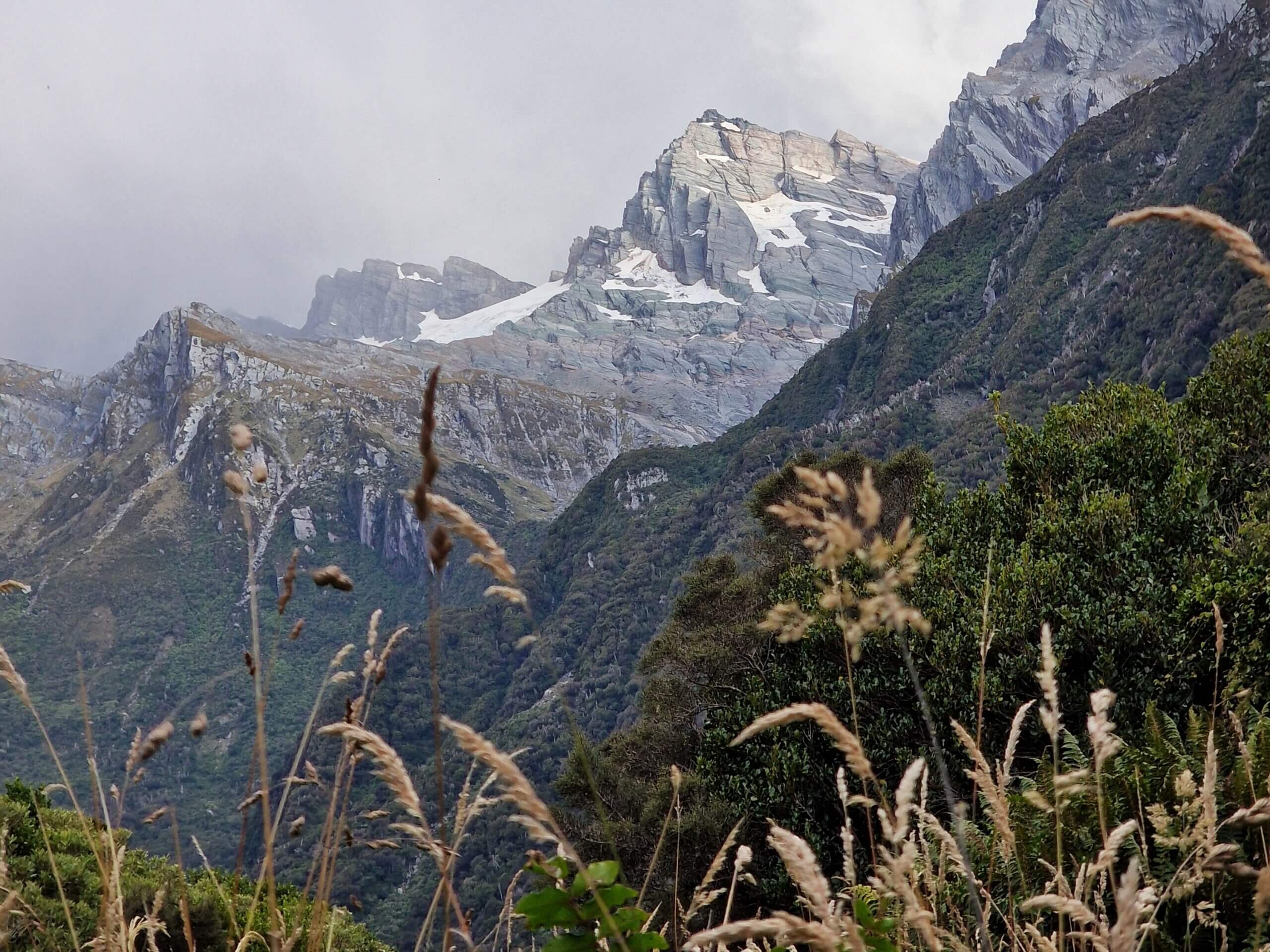
Trail Overview
- Distance: Approximately 17.5 kilometers one-way from Copland Car Park to Welcome Flat Hut
- Duration: Allow around 6-8 hours for the hike to Welcome Flat Hut, depending on fitness level and trail conditions.
- Difficulty: Moderate to challenging, with some steep sections and potential hazards like river crossings and landslide areas. I will describe these in more detail in the What You Need to Know section.
- Elevation: The highest point you’ll encounter on the Copland Track to Welcome Flat Hut is approximately 485 meters above sea level, just before you reach the hut. You can check out the elevation profile below, courtesy of the Department of Conservation.
- Season: Open year-round, but weather conditions can vary drastically. Check local forecasts before embarking on your hike.
Elevation Profile:

Trail Description
The Copland Track begins near the village of Karangarua on the West Coast of New Zealand’s South Island. It winds through lush rainforest and crosses several swing bridges over pristine rivers.
The track is well-maintained but can be muddy and slippery, especially after rain. Two notable landslide areas are marked along the route, requiring caution.
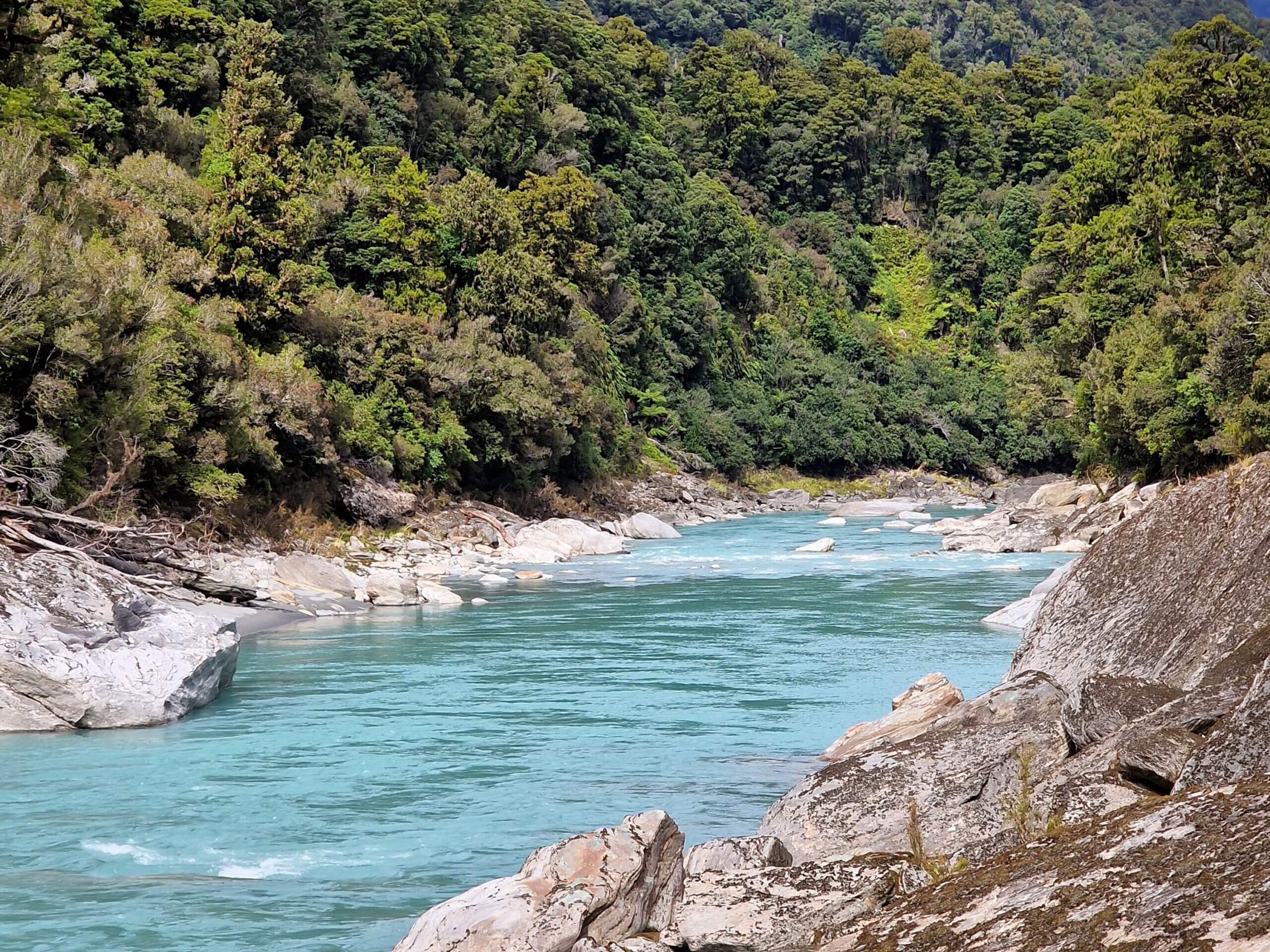
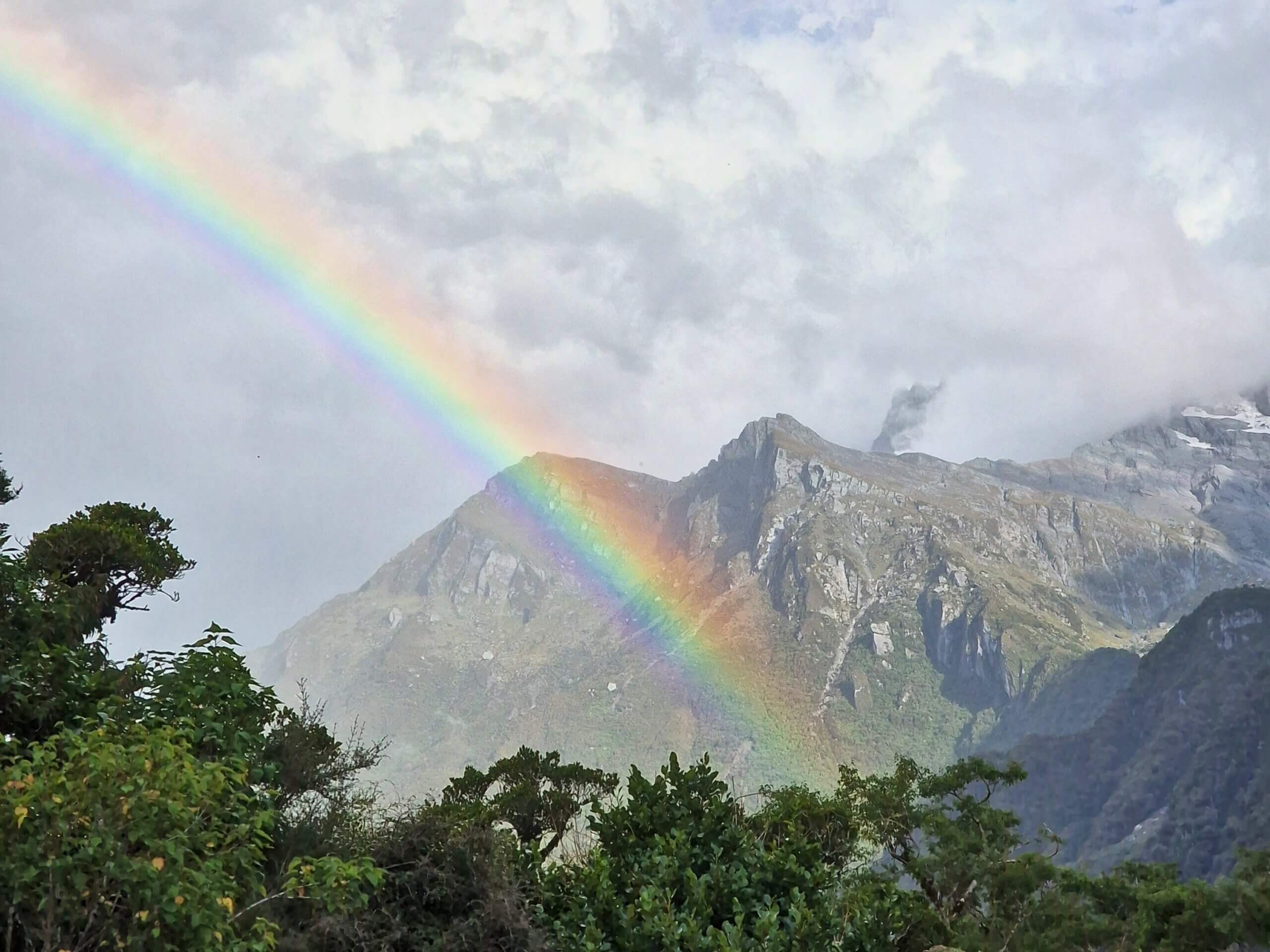
Highlights
- Architect Creek: A scenic spot approximately halfway to Welcome Flat Hut, perfect for a break and enjoying the surrounding scenery.
- Hot Pools: Natural thermal pools near Welcome Flat Hut, nestled in a picturesque valley with views of the Sierra Range. Ideal for relaxing and rejuvenating after a long hike.
- Flora and Fauna: Encounter diverse native flora, including towering Rimu and beech trees, as well as the chance to spot native bird species like the kea (alpine parrot).
Nearby Attractions
- Fox Glacier: Explore the nearby Fox Glacier, accessible via a short drive from Karangarua, offering guided tours and scenic viewpoints.
- Lake Matheson: Known for its reflective waters offering stunning views of Aoraki/Mount Cook and Mount Tasman. A short drive from Fox Glacier Village.
- Gillespies Beach: A rugged beach known for its scenic beauty and historical gold mining relics, accessible via a short drive from Fox Glacier.
What you need to know
River Crossings
When I researched hiking trails on the West Coast of South Island, New Zealand, and stumbled upon the Copland Track to Welcome Flat Hut, I was immediately drawn to it. However, one minor detail made me nervous about tackling it solo: the river crossings.
Despite my love for hiking, I don’t consider myself an experienced backcountry adventurer. Reading about Rough Creek and the need to cross it left me feeling anxious. But let me assure you: I had nothing to worry about.
Disclaimer: My experience is based on favorable weather conditions and should not be taken as general advice. Please use your own judgment, and avoid attempting this trail in bad weather. When it comes to river crossings; if in doubt, stay out.
The Copland Track to Welcome Flat Hut features only one major river crossing — Rough Creek, encountered shortly after the car park. Look for the orange marker on the opposite bank; this is where it’s recommended to cross.
After crossing Rough Creek, simply follow the well-defined path through the forest. There are a few more minor creek crossings along the track, but you’ll likely be able to navigate these without removing your hiking shoes.
Here are a few tips on how to cross a river safely:
- Evaluate the River: Assess the depth, current speed, and width of the river before attempting to cross.
- Find a Suitable Crossing Point: Look for wider sections with slower currents. Avoid narrow sections, bends, or areas with submerged obstacles.
- Unbuckle Your Backpack: Loosen your backpack straps and unbuckle the waist belt to easily remove it in case of an emergency.
- Use Trekking Poles: If available, use trekking poles for added stability. Cross the river diagonally downstream, leaning into the current slightly.
- Stay Together: If hiking with others, cross the river as a group, maintaining close contact and assisting each other if needed.
- Watch Your Footing: Step carefully on stable rocks or gravel, avoiding slippery surfaces like moss-covered rocks.
- Cross During Daylight: Attempt river crossings during daylight when visibility is better and avoid crossings in darkness or low light.
- Be Prepared to Turn Back: If conditions worsen or you feel unsafe during the crossing, retreat to a safe spot and reassess your options.
For more information on river safety, visit New Zealand Mountain Safety Council.

Landslides
On the track to Welcome Flat Hut, you’ll encounter two active landslide areas. These sections are about 30 minutes upstream of Architect Creek, on the true left of Shiels Creek, and are clearly signposted.
When the skies open up and the rain pours, those slopes become a lot more dangerous. The ground gets slick, the path uncertain. Tread carefully, especially during and right after heavy rain. This is the wild, raw and untamed, and it doesn’t forgive carelessness.
Keep your wits about you, and you’ll find the thrill in every step, every obstacle, and every stunning vista on your journey to Welcome Flat Hut.
Natural Hot Pools
Just a stone’s throw from the Welcome Flat Hut, you’ll find the hot pools—a slice of geothermal heaven with stunning views of the Sierra Range on a clear day.
But remember, this isn’t a luxury spa. It’s a delicate, natural environment. Leave the soaps and shampoos in your pack, and resist the urge to play amateur geologist by digging new pools.
And a word to the wise: keep your head above water to dodge the nasty threat of amoebic meningitis. Enjoy the raw beauty, respect the fragility, and soak in the adventure.
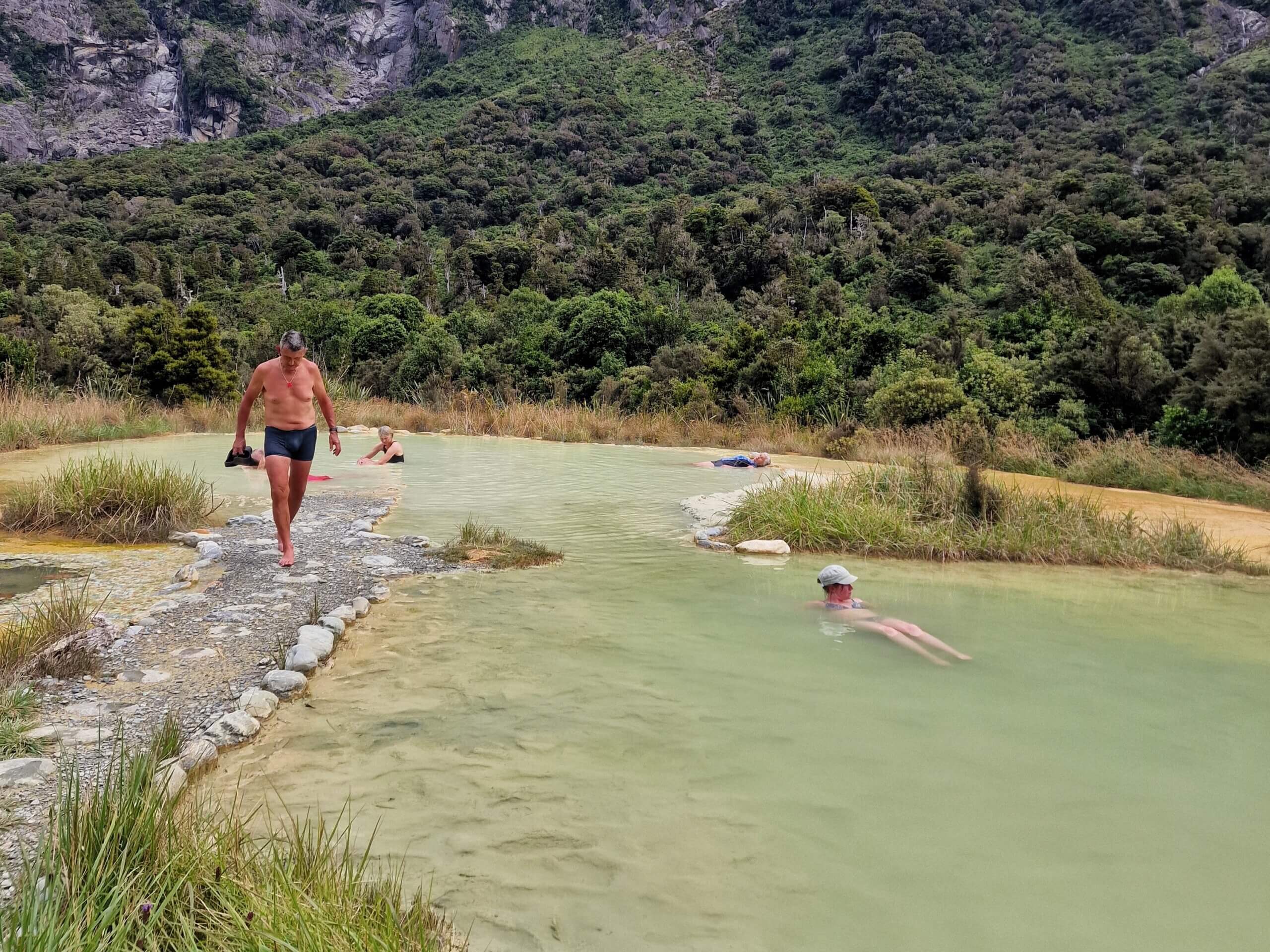
Sandflies
Sandflies—tiny, relentless, and absolutely maddening. The West Coast of the South Island? It’s their kingdom. These little bastards thrive in the fast-flowing bush streams that crisscross this region, turning every hiker’s dream into a buzzing nightmare. They’re always around, but you’ll find them especially bothersome when it’s cloudy, shady, or just before the heavens open up—and if you didn’t know, it rains a hell of a lot on the West Coast.
The worst assault I faced was at Rough Creek. I took off my hiking shoes and rolled up my leggings to keep them dry, but I didn’t account for the sandflies. My legs ended up soaked with blood from the sheer number of those relentless little vampires. Thankfully, the rest of the track wasn’t too bad when it came to sandflies.
Another hotspot for sandflies is the natural hot pools by Welcome Flat Hut. The best defense? Get into the water quickly and stay submerged. If even a sliver of skin is exposed, those little pests will find it.
Timing is also key. Wait until sunset or sunrise, when sandfly activity drops significantly. And once it gets properly dark, you’re in the clear.
Here are a few tips to fend off sandfly bites:
- Keep moving: Staying active makes it harder for them to latch on.
- Cover up: When you’re not on the move, especially protect your ankles and feet.
- Use insect repellent: Opt for those with diethyl toluamide or dimethyl phthalate.
- Burn citronella candles: These can help keep sandflies at bay in a small area.
- Take extra Vitamin B: This might boost your immunity to their bites.
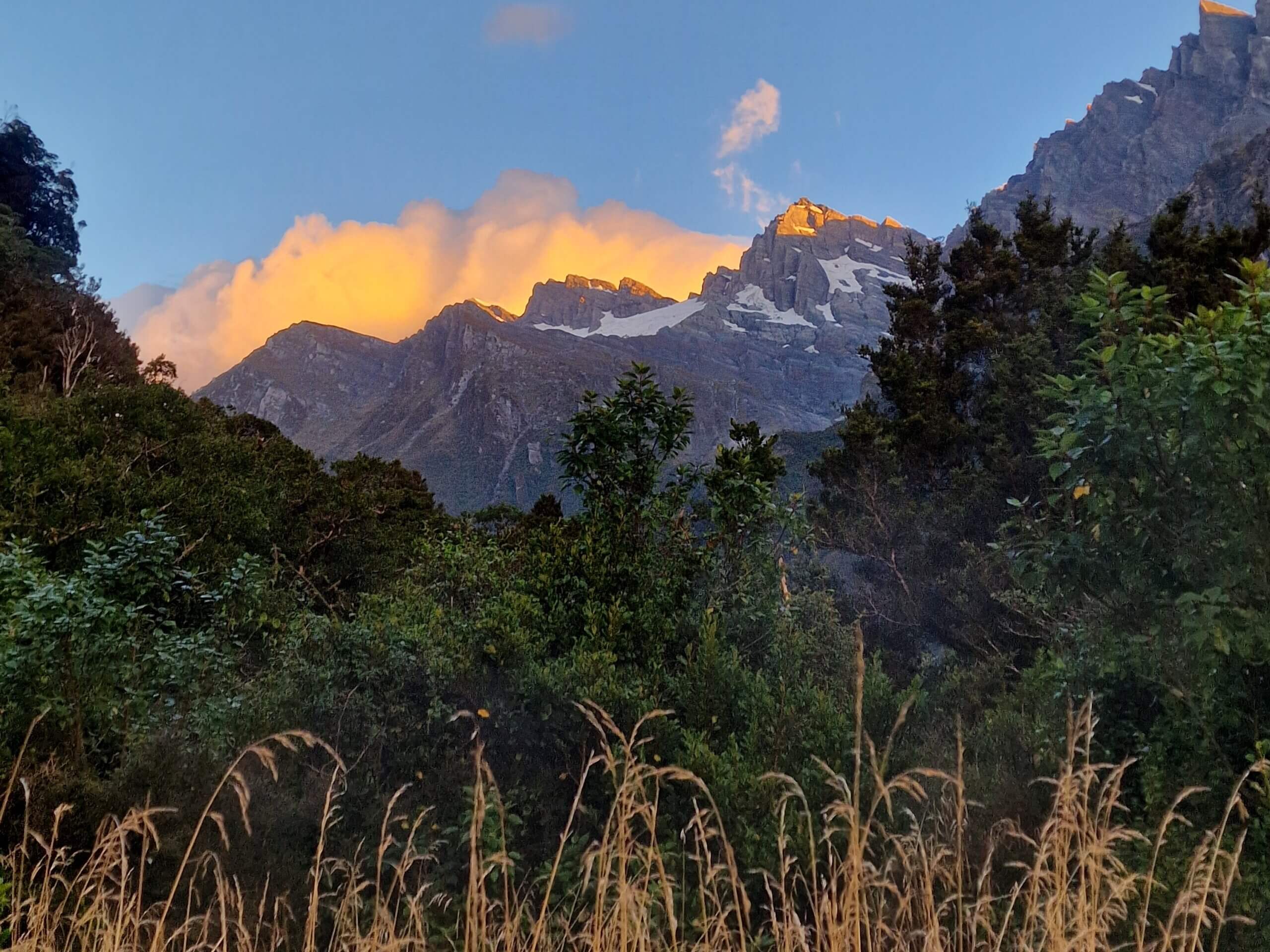
Going Solo
Hiking the Copland Track to Welcome Flat Hut as a solo female traveler had me worried, mostly because of the river crossings that I wasn’t keen on doing alone. But here’s the beautiful thing about solo travel: you’re rarely alone.
On the bus, I met Jack, a German traveler. I mentioned my plan to hike the track, and he was instantly in. The next day, while hitchhiking, I got picked up by Mathieu, a French traveler and fellow hiker. I invited him to join us, and he gladly accepted. On the trail, we ran into Aron, an American traveler, and he ended up walking with us too.
So, when it comes to solo traveling, this I’ve learned: You’re never alone unless you want to be.
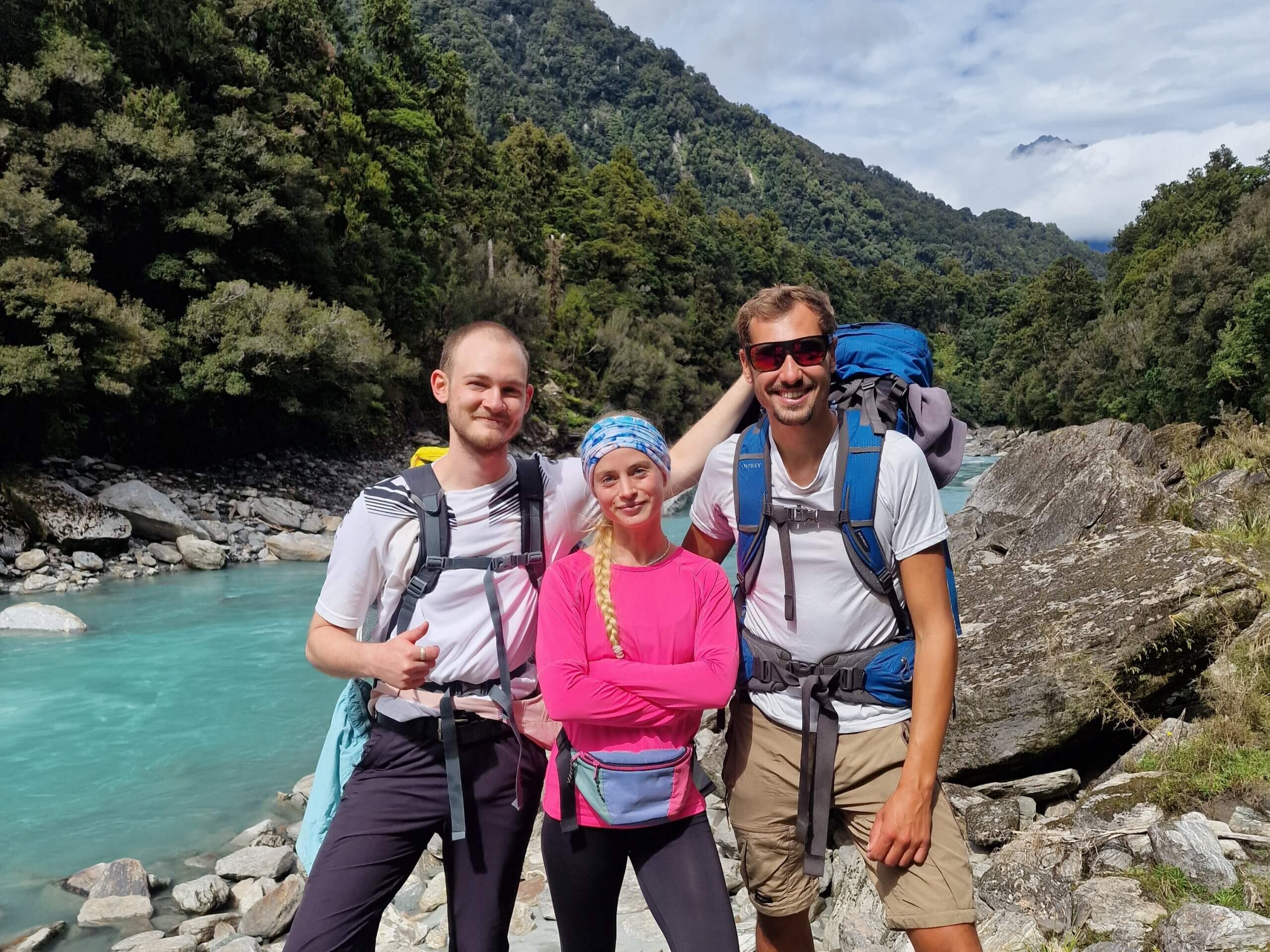
Want some company on the trail? Here’s how to make it happen:
- Hostel Hangouts: Hostels are like traveler magnets. Chat up fellow adventurers over breakfast or in the common area. You might just find your next hiking buddy.
- Street Smarts: Strike up conversations anywhere—supermarkets, bus stops, sidewalks. Share your hiking plans and see if someone’s game to join. You never know who’s up for an adventure.
- Facebook Finds: Join New Zealand Hiking or Backpacker Groups on Facebook. It’s a goldmine for connecting with like-minded souls itching to hit the trails.
- Couchsurfing Connections: Couchsurfing isn’t just about crashing on someone’s couch. It’s a community of travelers and locals. Reach out, and you might score a hiking partner who knows the terrain like the back of their hand.
In the world of travel, companionship is just a conversation away. But with all that being said, if you can’t find anyone to go with you, go alone! I quickly realized on the Copland Track to Welcome Flat Hut that I could’ve easily tackled the hike by myself.
Safety
Hiking the Copland Track to Welcome Flat Hut offers stunning landscapes and adventurous challenges. To ensure a safe and enjoyable journey, consider the following precautions:
- Safety First: Inform someone about your plans, including your expected return time — and check in with them upon your return.
- Weather Watch: The West Coast weather is notoriously unpredictable. Check the forecast and be prepared for sudden changes. Carry appropriate clothing and gear for all conditions. Heavy rain can make river crossings and landslide areas particularly dangerous, and DOC may even close the trail.
- Essential Gear: Carry a well-stocked first aid kit, a reliable map, and a compass or GPS device. Make sure you have enough food and water for the journey, plus extra in case of delays.
- Navigation: The track is well-marked, but always be aware of your surroundings. Pay extra attention in areas prone to landslides and river crossings.
- River Crossings: Evaluate river crossings carefully. After heavy rain, rivers can swell quickly and become dangerous to cross. Consider waiting for water levels to decrease or finding an alternative route.
- Stay Connected: A personal locator beacon (PLB) is nice to have, especially for solo hikers. In case of an emergency, this device can send a distress signal to rescuers.
- Wildlife and Insects: Be prepared for encounters with sandflies, especially around water and at lower elevations. Carry insect repellent and wear long sleeves and pants to minimize bites.
- Hot Pools Etiquette: When you reach the hot pools at Welcome Flat Hut, remember to respect the fragile environment. Avoid using soaps or shampoos in the pools, and follow guidelines to keep the area pristine for future hikers.
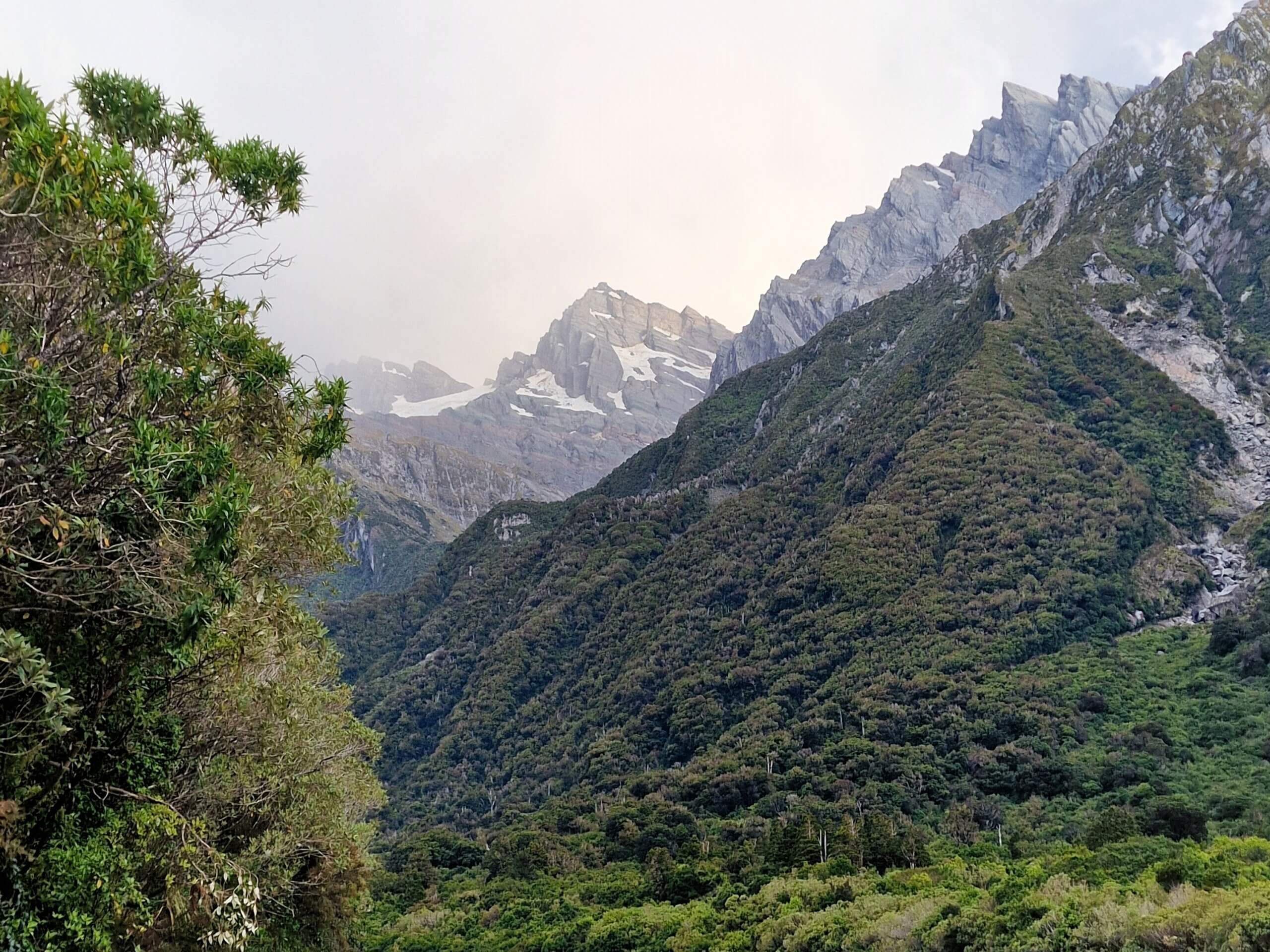
Getting There
There are three ways to reach the Copland Car Park, where you’ll start your ascent towards the Welcome Flat Hut.
Drive
The easiest way to get to the Copland Track is by driving yourself. Maybe you already have a car; if not, it’s possible to rent one. Start your engine and seize the road.
Rental Car
There are many car rental options available on the South Island of New Zealand. Most rentals will need to be picked up in Christchurch, or if Queenstown’s your launchpad, you might be able to rent one there, too. Check out available cars for hire here.
Parking
There are free parking spots provided by the Department of Conservation at the Copland Car Park. If you’re struggling to find a spot to park, there’s actually more than one car park — the first one is on the road itself, but if you open the gate leading to the Copland Track and drive just a little further down that road, there is another car park right before the first river crossing.
Are you enjoying my content?
Please consider supporting me by buying me a cup of coffee, or a pizza! 🙂
Public Transport
It is possible to take the Intercity bus to the trailhead. The bus stop is called “Copland Track (Karangarua),” which is what you’ll enter into the search bar when finding your route and buying a ticket.
Snag your bus ticket to Copland Track to Welcome Flat Hut on the Intercity website.
If you’re not already bunking within a reasonable distance to the Copland Track to Welcome Flat Hut, you might want to consider booking accommodation in Fox Glacier or Franz Josef the night prior, so you can start your trek early. Check out my picks in the “Where to Stay” section.
I bought a FlexiPass with Intercity when I was traveling South Island, which was quite handy and recommendable if you’re a carless wanderer like me.
Hitchhike
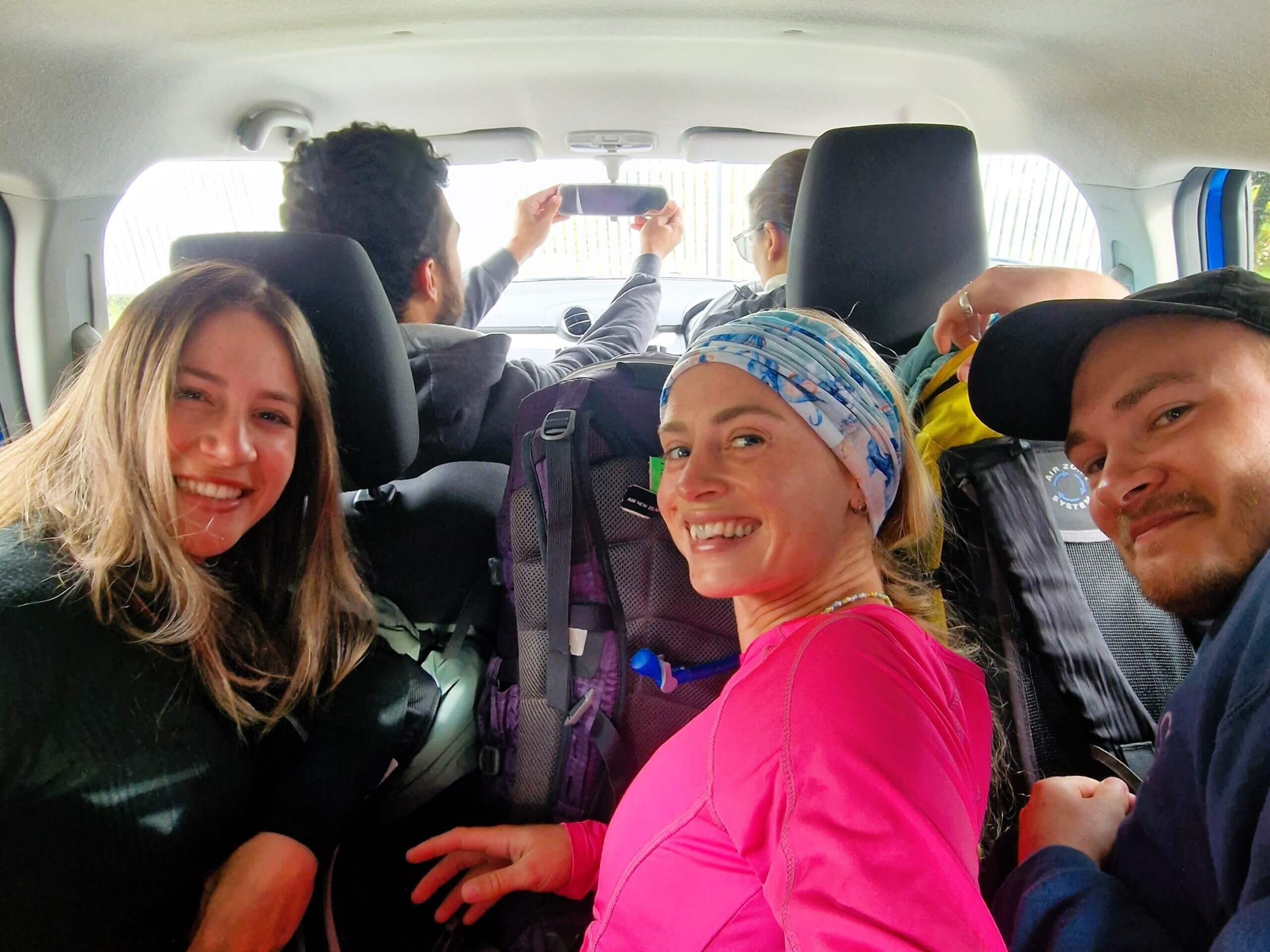
I opted for the thumb-and-tarmac route to the Copland Track because I didn’t know you could actually take the bus there.
I was staying in Franz Josef, which is a 50-minute drive away. I stood on the outskirts of town, right after the Franz Josef Fire Station, where cars heading south pass by. It only took around 10 minutes for a car to whisk me away — a charming elderly French duo picked me up, and it was a joyful ride.
Hitchhiking is very popular in New Zealand, but you need a flexible schedule and a good amount of patience for this. You might snag a direct ride, or you could play car roulette, hopping from one lift to the next.
Please use your judgment and hitchhike at your own risk.
Where to stay
Before you go
Fox Glacier
The cheapest and closest accommodations I have been able to find near the Copland Track are located in the town of Fox Glacier, a mere 25-minute drive from the trailhead.
A popular budget-friendly place to stay in Fox Glacier is Ivory Towers Hostel. I visited some friends there, and the place had a chill, friendly vibe.
Check out accommodation options in Fox Glacier
Franz Josef
The second closest and cheapest accommodations can be found in the town of Franz Josef, which is a 50-minute drive from Copland Car Park.
I stayed at Chateau Backpackers & Motel in Franz Josef before and after doing the Copland Track to Welcome Flat Hut. They allowed me to leave my big bag in a locker, so I could hit the trail unburdened by the weight of excess stuff.
Check out accommodation options in Franz Josef
Bonus Info
A funny yet awesome thing about the hostels on the West Coast of South Island, New Zealand, is that most of them serve free soup every night and also have a hot tub. This is true for both Chateau Backpackers and Ivory Towers, along with other hidden gems in these lively towns.
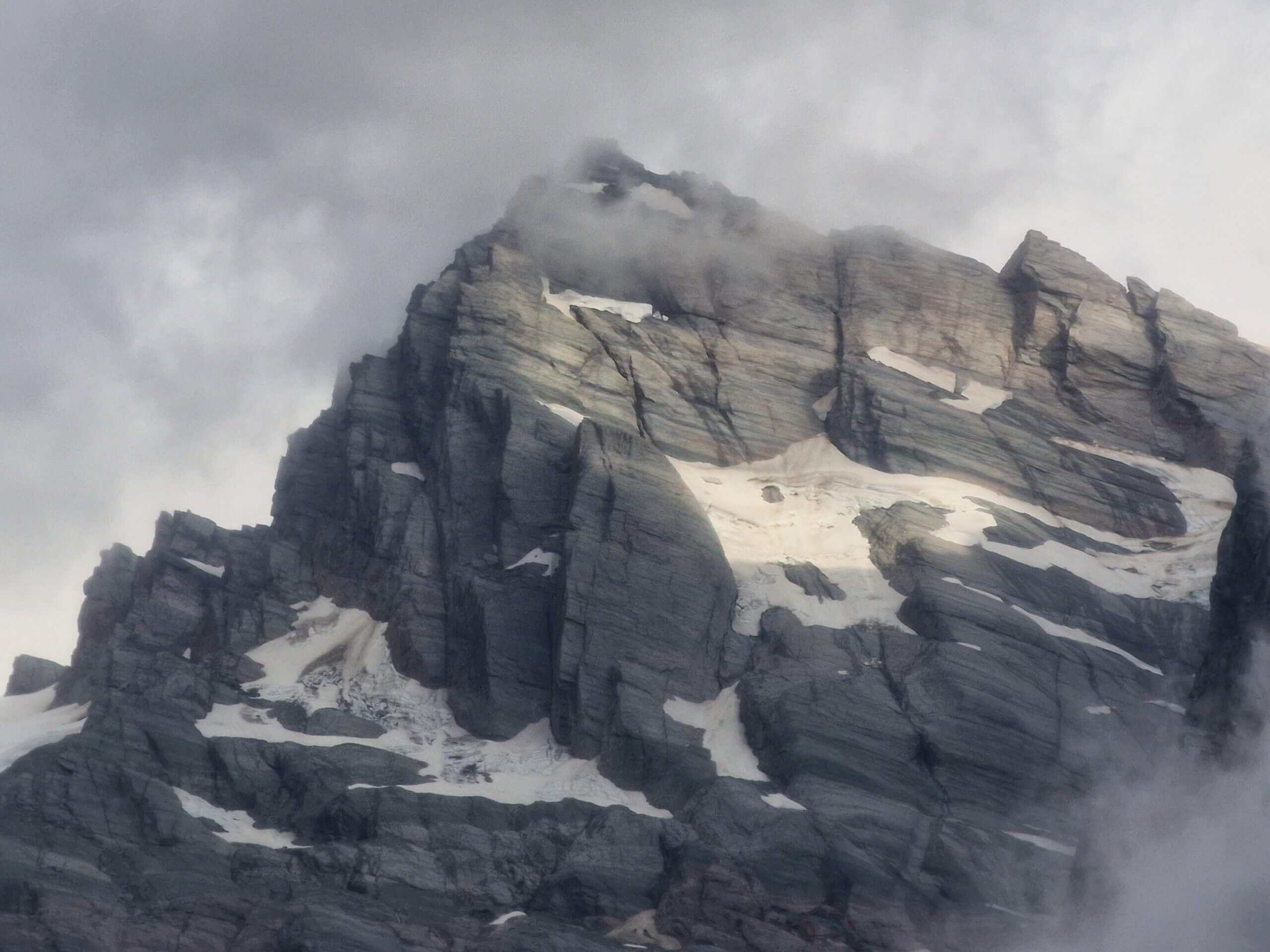
Welcome Flat Hut and Camp Site
If you plan on staying overnight in the Welcome Flat Hut or Camp Site, you need to book in advance!
You can book Welcome Flat Hut and Camp Site here.
Welcome Flat Hut
The Welcome Flat Hut offers 31 bunk beds. It’s a free-for-all; your booking grants you a bed, but the choice is yours when you arrive. First come, first served.
I payed 30 NZD for one night at the Welcome Flat Hut. Worth every penny for the experience, but don’t expect luxury.
Cooking facilities? None. Bring your own gas burner if you’re keen on a hot meal. I opted for the no-fuss route: sandwiches and snacks. It’s a simple way to nourish yourself after a day on the trail.
And here’s a pro tip: pack it in, pack it out. The Copland Track has no rubbish facilities. Your trash is your problem, so bring a rubbish bag and carry it back out with you.
Water is available from a tap at the hut. The rangers assured me it was safe to drink, and I survived just fine. But the Department of Conservation plays it cautious, advising you to treat it first — boil for three minutes or use purification tablets.
The hut has heating options to take the edge off those chilly nights, and there are non-flush toilets to handle your business. It’s basic, but it’s all part of the charm.
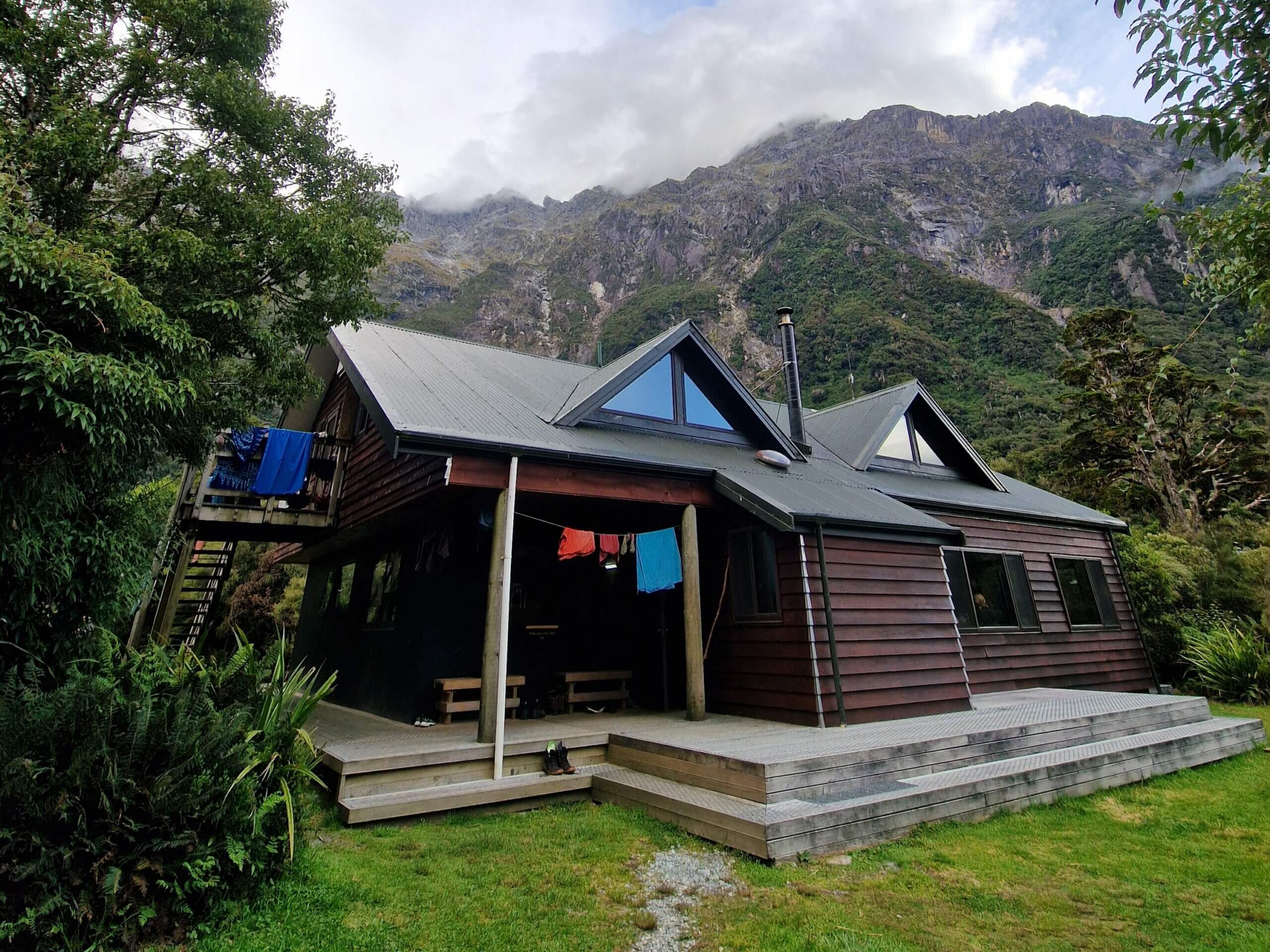
Welcome Flat Camp Site
Nestled snugly behind the hut, amidst the stunning mountains, lies the Welcome Flat Camp Site. Here, you’ll find 8 tent sites available.
You can secure yourself a spot at the camp site for the neat price of 15 NZD.
Even if you opt for the campsite over the hut, fear not. You still have access to the essential amenities: toilets and tap water. And between you and me, I reckon you could sneak into the hut’s common area and chill without anyone being mad at you. But hey, you didn’t hear it from me.
Welcome Flat Sierra Room
If you want to splurge, there’s even the option to rent your own room in the Welcome Flat Hut. It’s called the Sierra Room, and with space for up to four, this lavish accommodation offers a taste of luxury amidst the rugged wilderness.
The Sierra Room cost 132 NZD (split the bill if you’ve got comrades in arms).
Equipped with gas cooking facilities, a pot-belly stove, and even a shower, this room redefines camping in style. Located within the main building yet boasting separate access, it’s the epitome of exclusivity.
Toilets are still shared with the rest of us.
Note: Prices may be subject to change.
You can read more about the Welcome Flat Hut here, and book your spot here.
Packing List
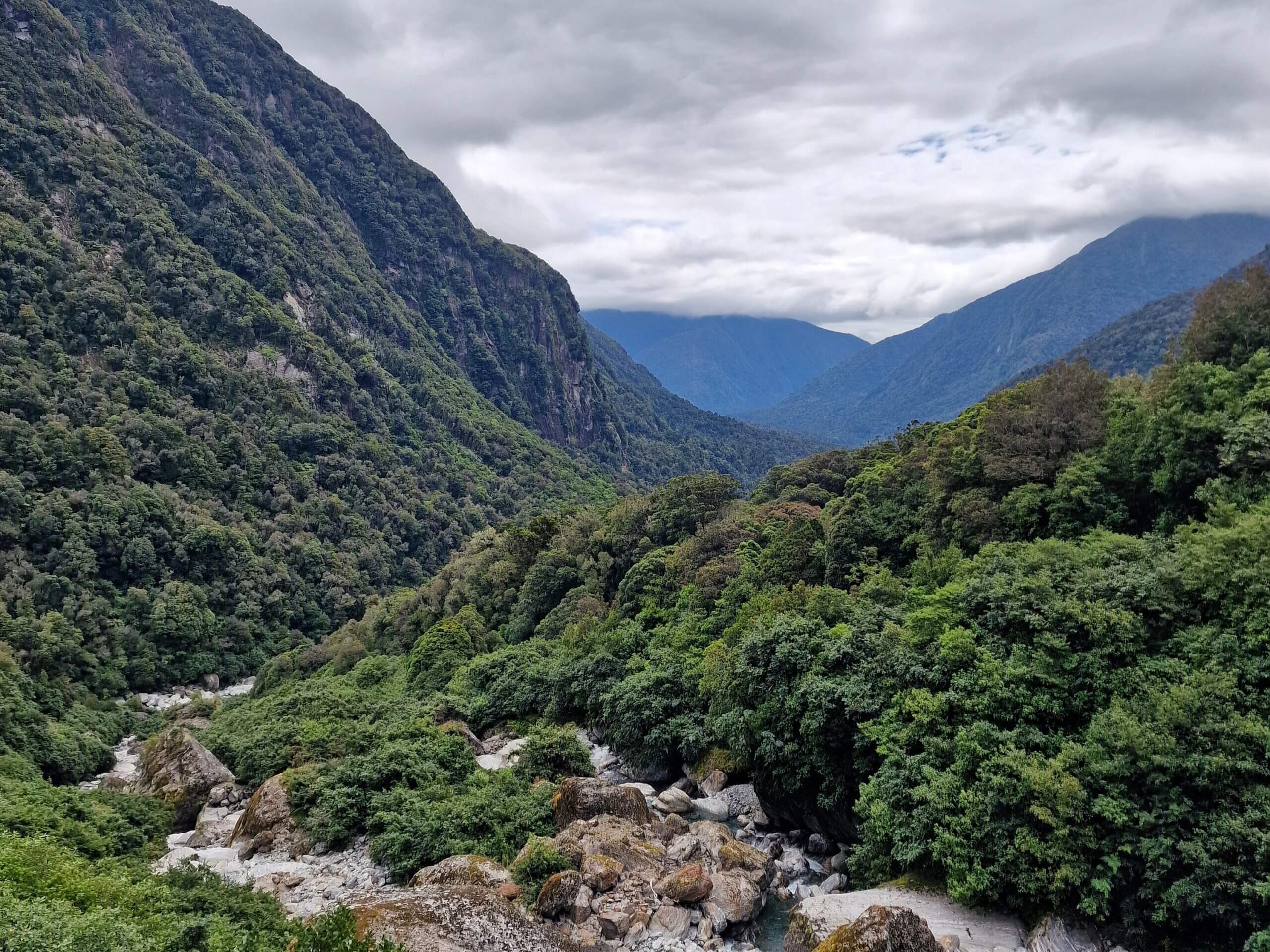
Personal Gear
- 36 Liter Backpack
- Bumbag
- Sleeping bag (Comfort Temperature 5 degrees)
- Water Bladder 1.5 L
- Foldable Water Bottle 0.5 L x 2
- Water Purification Tablets
- First Aid Kit
Clothing
- Fleece Shirt
- Sweatpants
- Leggings
- Shorts
- Long-Sleeved Top
- T-Shirt
- Sports Bra
- Rain Jacket
- Rain Pants
- Cap
- Woolen Socks
- Hiking Shoes
- Crocs
Depending on the season you’re doing this track, you might want to add a warm hat and gloves and more layers.
Toiletries
- Sunscreen
- Moisturizer
- Lip Balm
- Toothpaste
- Toothbrush
- Baby Wipes
Electronics
- Samsung Galaxy S22 Ultra
- GoPro + two batteries
- Powerbank
Other
- E-Reader
- Rubbish bags
- Headlamp
- Earplugs
Food
- Sandwich Bread
- Sandwich Topping
- Tuna can x 1
- Carrot x 3
- Apple x 3
- Peanuts
- Muesli Bar x 4
I didn’t bring a gas burner with me on this track, hence the simple selection of foods.
You can find several more suggested packing lists on the Department of Conservation’s webpage.
My Experience
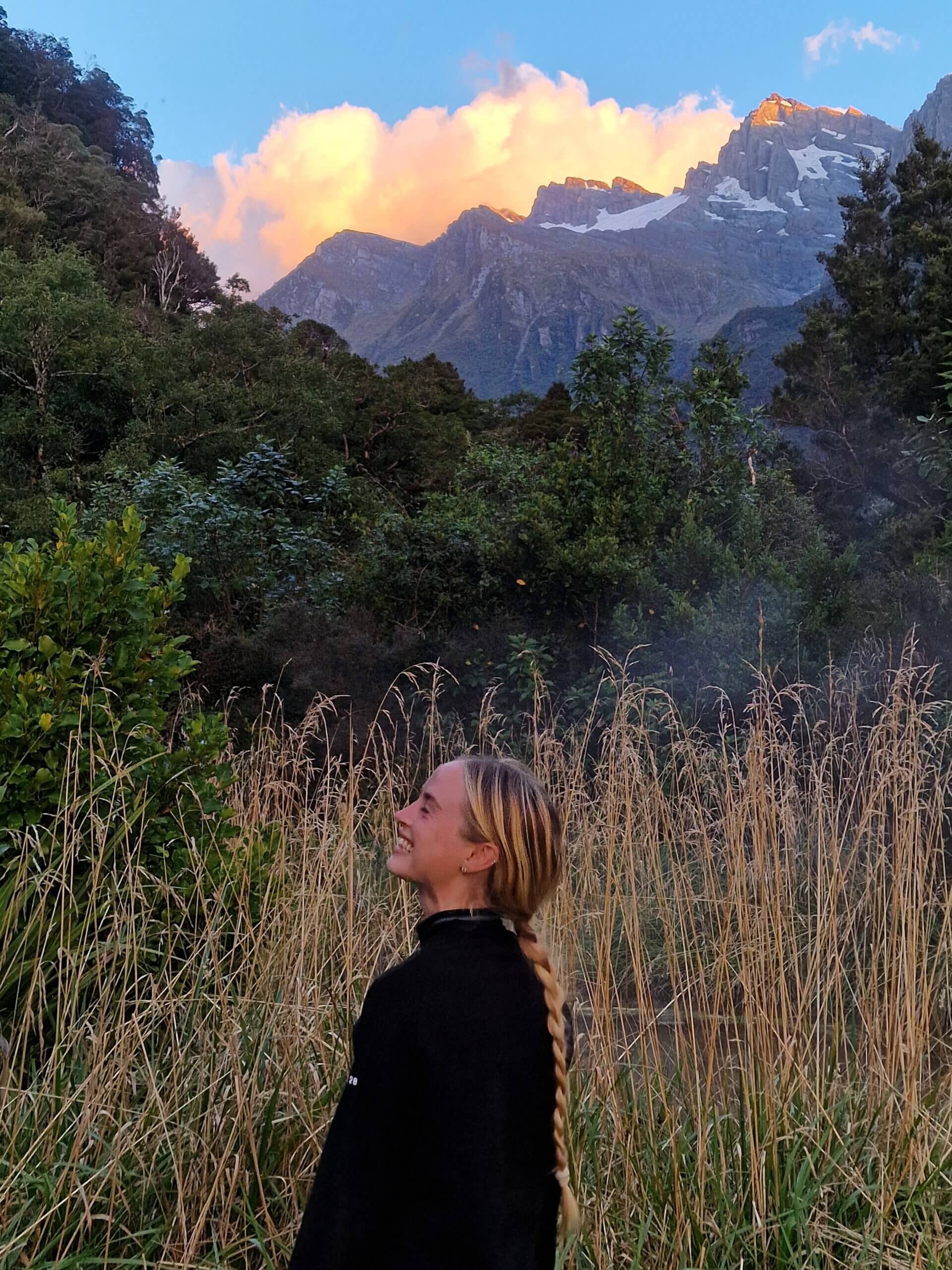
The Randomness of Travel
Waking up to a clear sky at the Franz Josef hostel, just 50 kilometers north of the trailhead, set the stage for my adventure. Breakfast at Chateau Backpackers was a carb-loaded affair — waffles aplenty and a hearty bowl of porridge — essential fuel before tackling the Copland Track to Welcome Flat Hut.
After stashing my oversized backpack in one of Chateau Backpackers’ trusty security lockers, I hit the road. I didn’t wait long with my thumb outstretched before a friendly French couple whisked me along, sharing stories and laughter along the way.
I was hitching a ride to Fox Glacier, where I would meet up with Jack, a fellow traveler I’d met on the bus a few days prior, who was instantly onboard when I mentioned my hiking plans.
Arriving in Fox Glacier, Jack had secured our next ride with one American and two Brazilians who were headed in the right direction. Crammed into the car, I couldn’t help but revel in the randomness of travel; this spontaneous convergence of travelers, each with their own tales and motivations, a series of fleeting yet profound connections that I always touch my heart deeply.
At the trailhead, Jack and I met up with Mathieu, a French traveler who had graciously picked me up while hitchhiking days earlier and now joined our ranks. Together, we embarked down the path, our first challenge looming ahead: the river crossing.
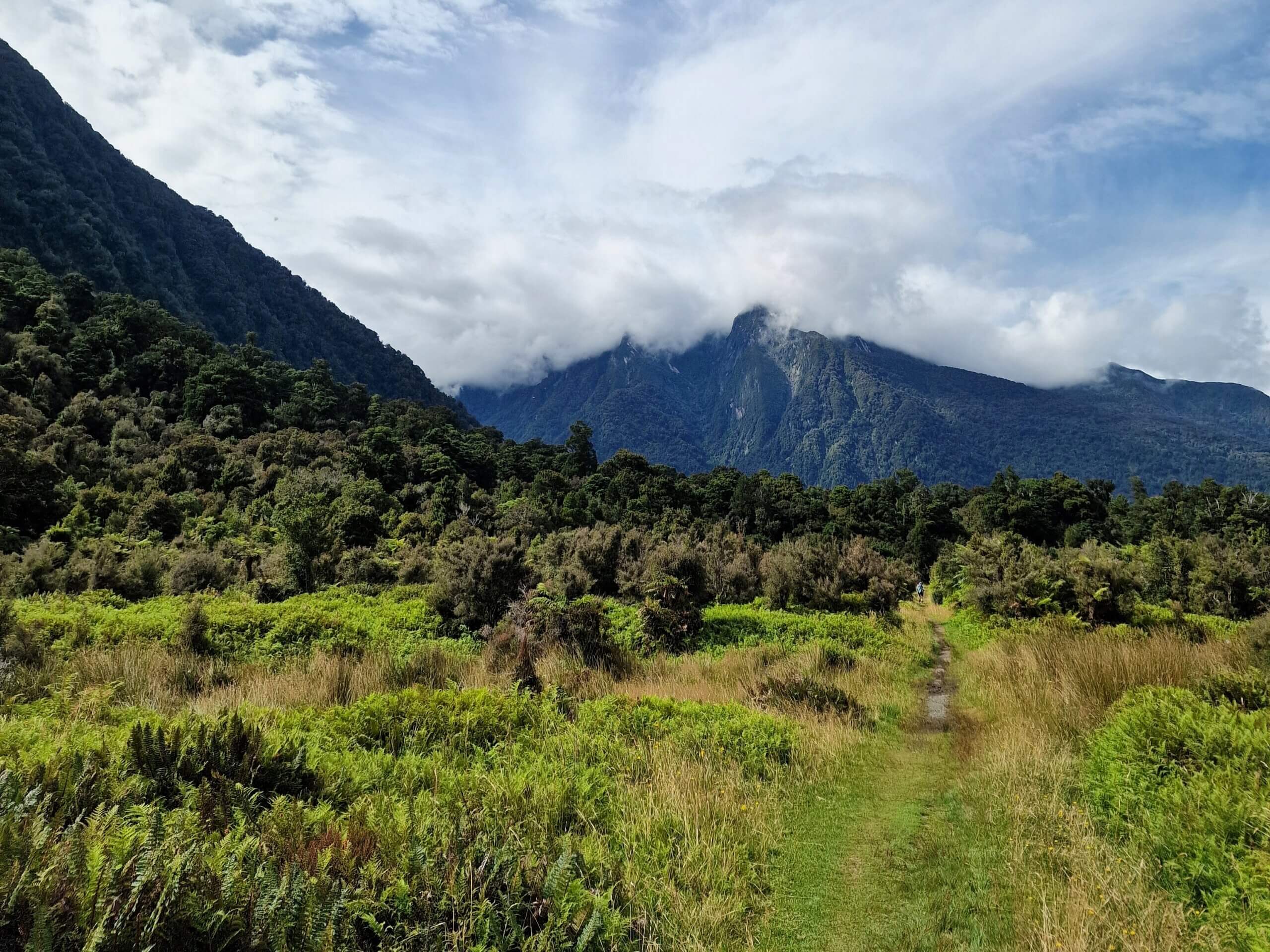
A Feast for Sandflies
I kicked off my hiking shoes, unwilling to endure the next 17.5 kilometers with soggy feet, and rolled up my leggings. I was prepared for the river, but what I hadn’t anticipated were the onslaught of over a hundred sandflies swarming my exposed legs, feasting on my flesh and leaving bites that drew blood.
Navigating through the river, initially my main concern after reading about the challenges of river crossings on this trail, turned out to be surprisingly manageable. The water only reached mid-calf, and the current was gentle, making the crossing smooth and straightforward.
Once safely on the other side, I swiftly slipped back into my hiking shoes and rolled down my leggings. With renewed determination, the three of us ventured into the forest, marking the official start of our hike.
Sweat and Swing-Bridges
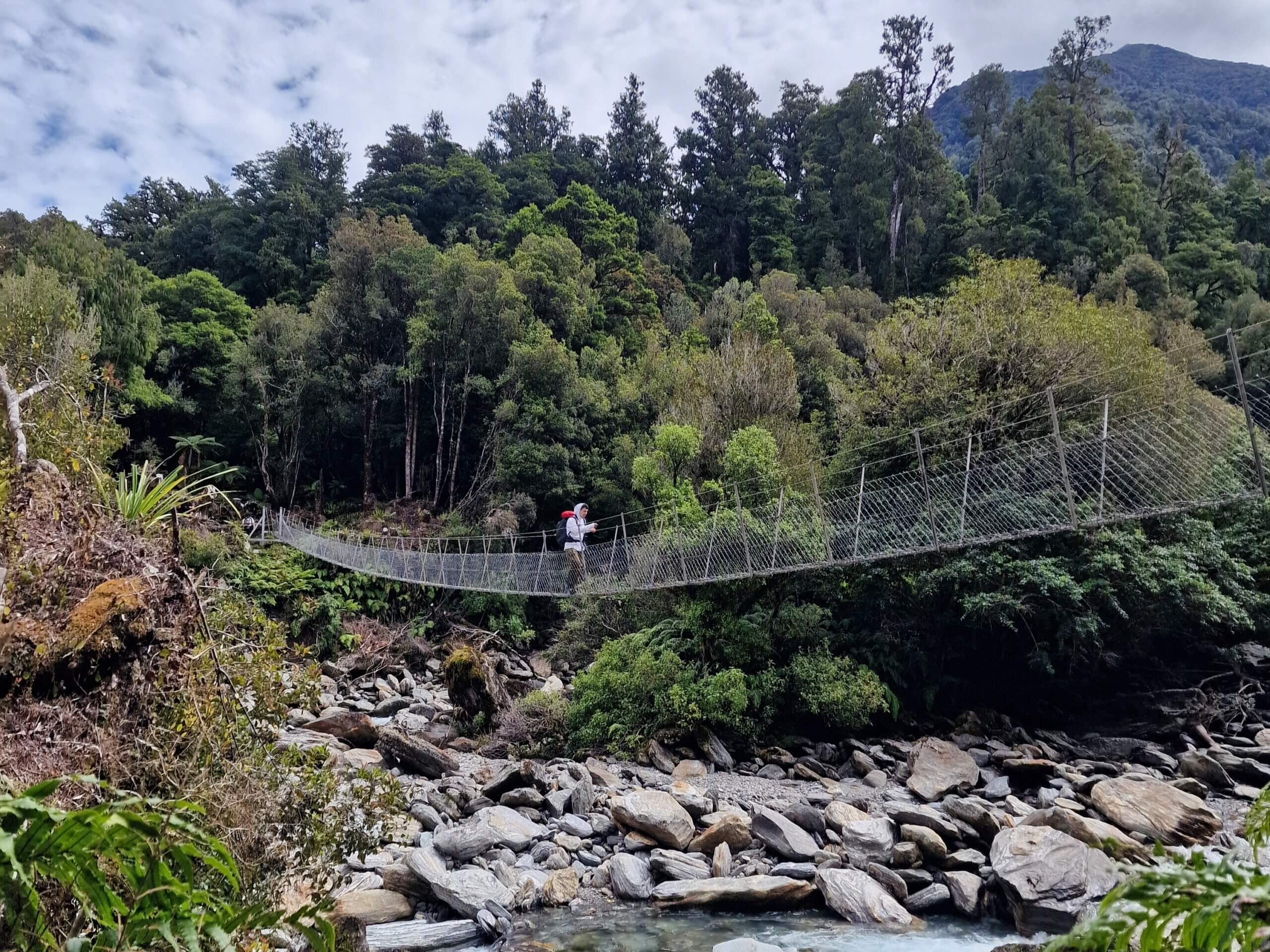
The hiking trail surprised me with its initial gentleness. For quite a stretch, it was a leisurely stroll on level ground, with only a few creeks to hop over and puddles to dodge. But as we pressed on, the terrain began to rise, and the sweat began to pour from my armpits.
Soon, we encountered several swing bridges, adding an extra dash of adventure to our journey. From these airy crossings, we savored breathtaking views: one side revealed a crystal-clear blue river, while the other showcased lush, enveloping forest.
The boys had a good pace, and I did my best to keep up with my short person legs and weighty backpack. Invariably, we passed everyone we encountered along the way, fueled by growing anticipation for what lay ahead: the natural hot pools, where we could unwind against the backdrop of the majestic Sierra Range.
Welcome to Welcome Flat Hut
Around 4 pm, we made it to the Welcome Flat Hut, as some of the first arrivals of the day. A few folks were already settled in, having arrived the day before and opting to stay two nights. The idea of lingering longer hadn’t crossed my mind, but surrounded by the towering Sierra Range, I was already kicking myself for not planning a longer stay.
Mathieu secured himself a campsite, while Jack and I claimed two mattresses in one of the hut’s four rooms, choosing ones with a lovely view through skylights.
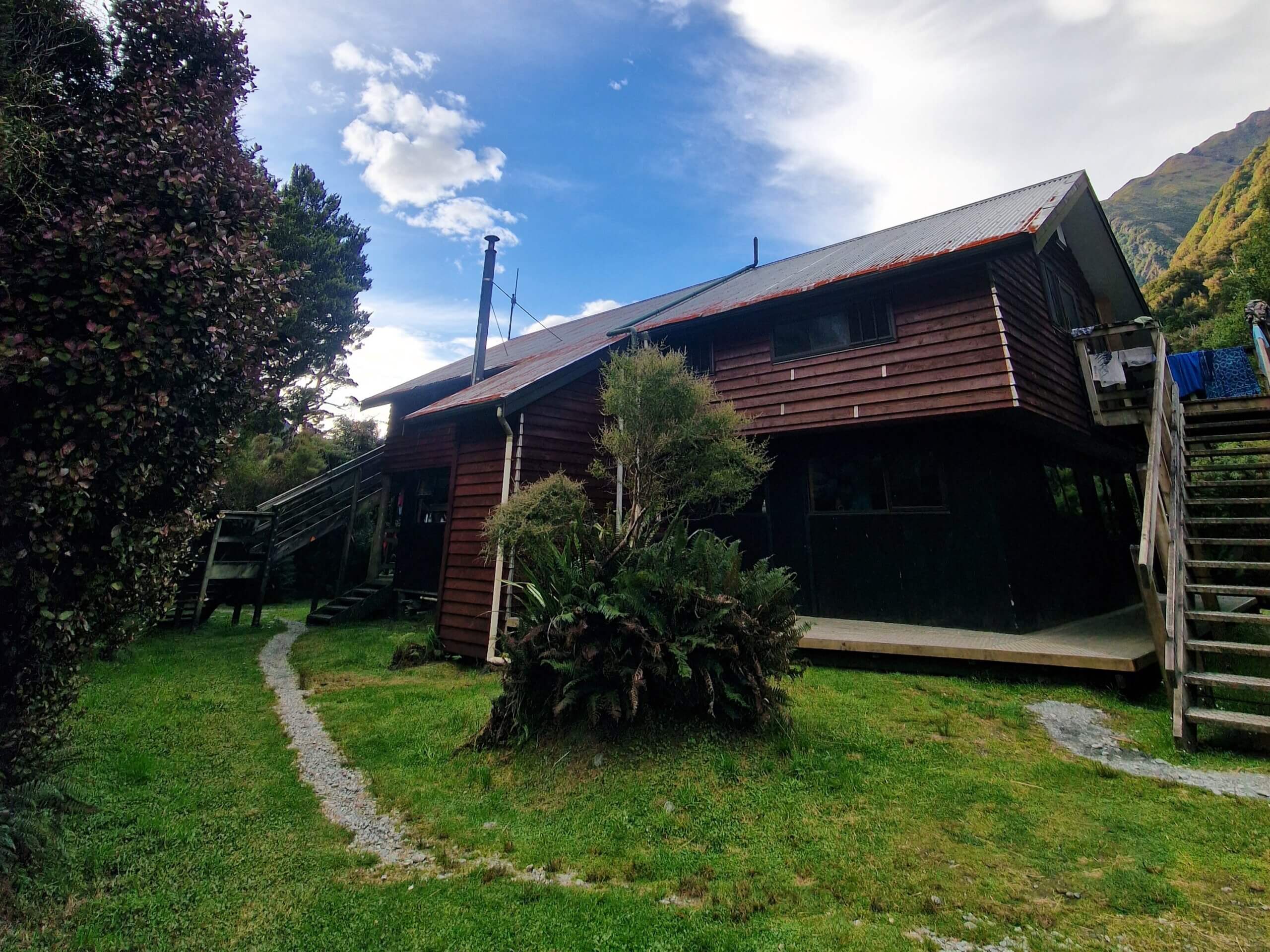
The hut itself was simple, but sweet. There was a bathroom outside that had a sink with running water, taps in the kitchen area, and large benches perfect for socializing. One side of the hut opened to natural hot pools, the other to a flowing river.
I went for a little walk around the premises, soaking up my surroundings. There’s nothing that can take my breath away like pristine nature, the feeling of insignificance amidst the mountains. And then, as if nature decided to outdo itself, a rainbow appeared — pure magic.
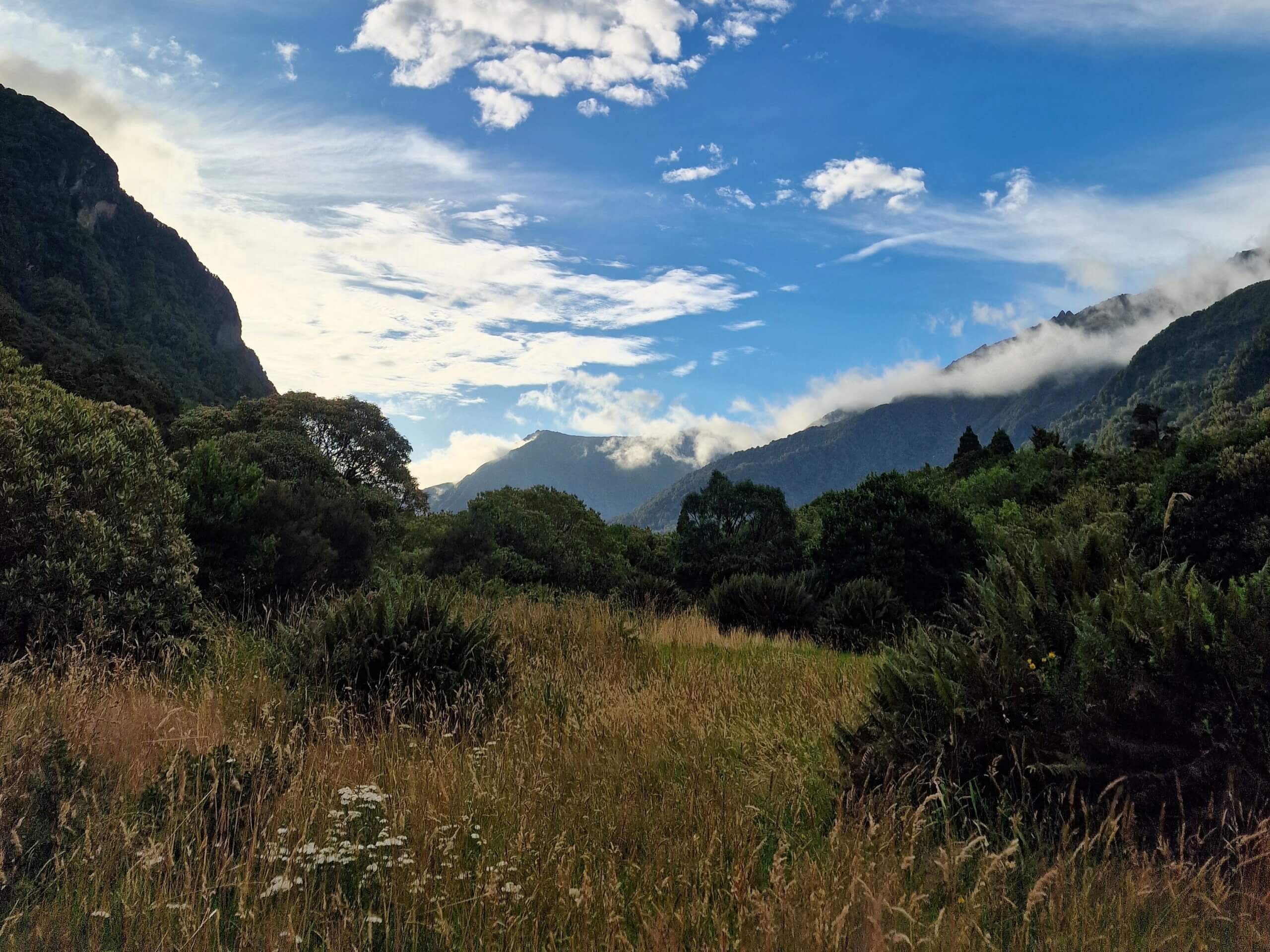
Hot Pools and High Peaks
Stripping out of my sweat-soaked clothes and letting them dry, I slipped into my swimwear and headed for the natural hot pools—a short stroll from the hut. I had planned to take a few photos, but the relentless sandflies were already feasting on my legs, so I hurried along.
There were three different natural pools with different temperatures. I opted for the one with the lowest temperature, but trust me, it was still plenty hot. Sitting up with your upper body out of the water helped regulate your temperature, but it left you vulnerable to the sandflies. Still, it was considerably better to be inside the water than outside in regard to bites.
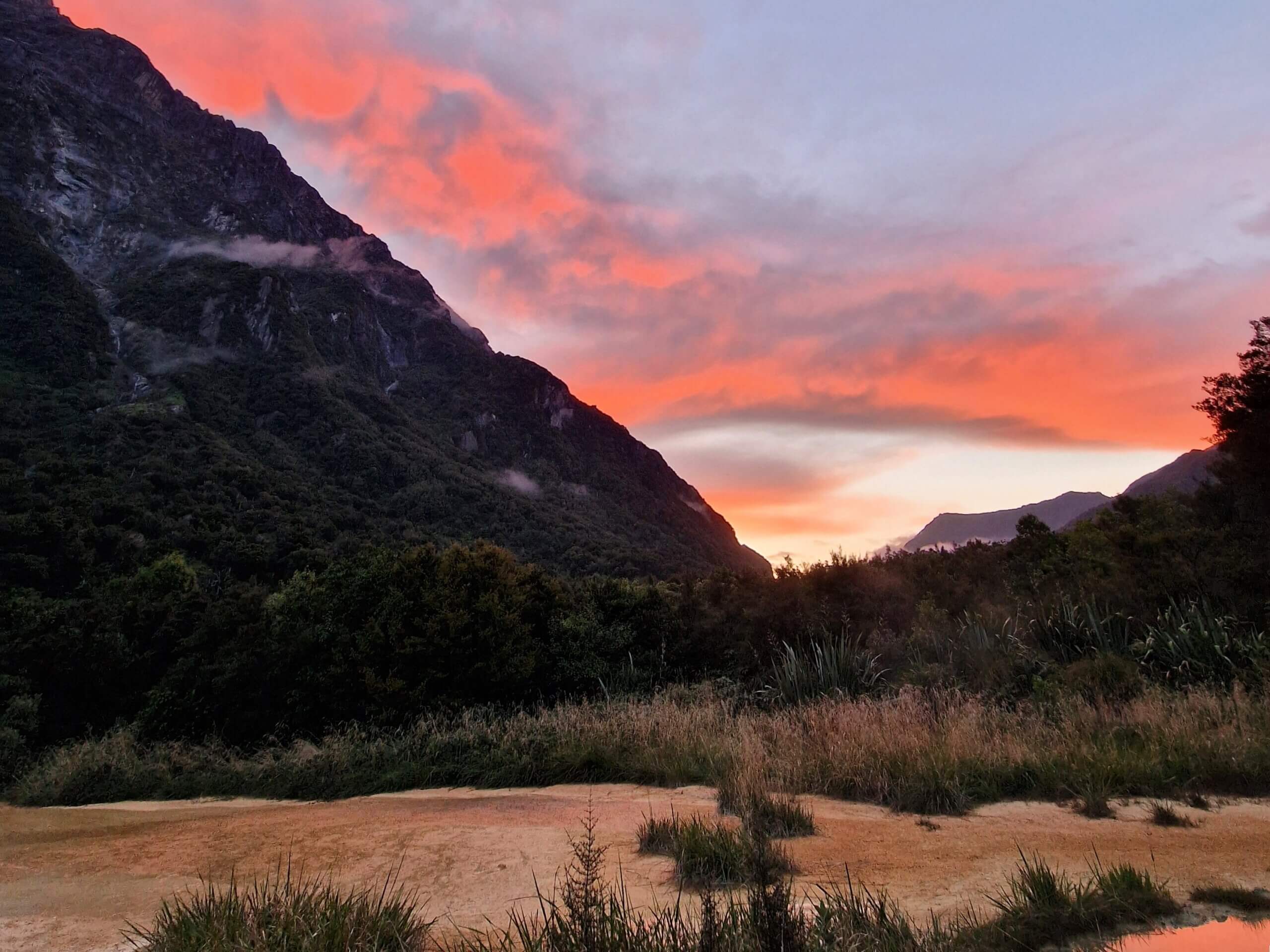
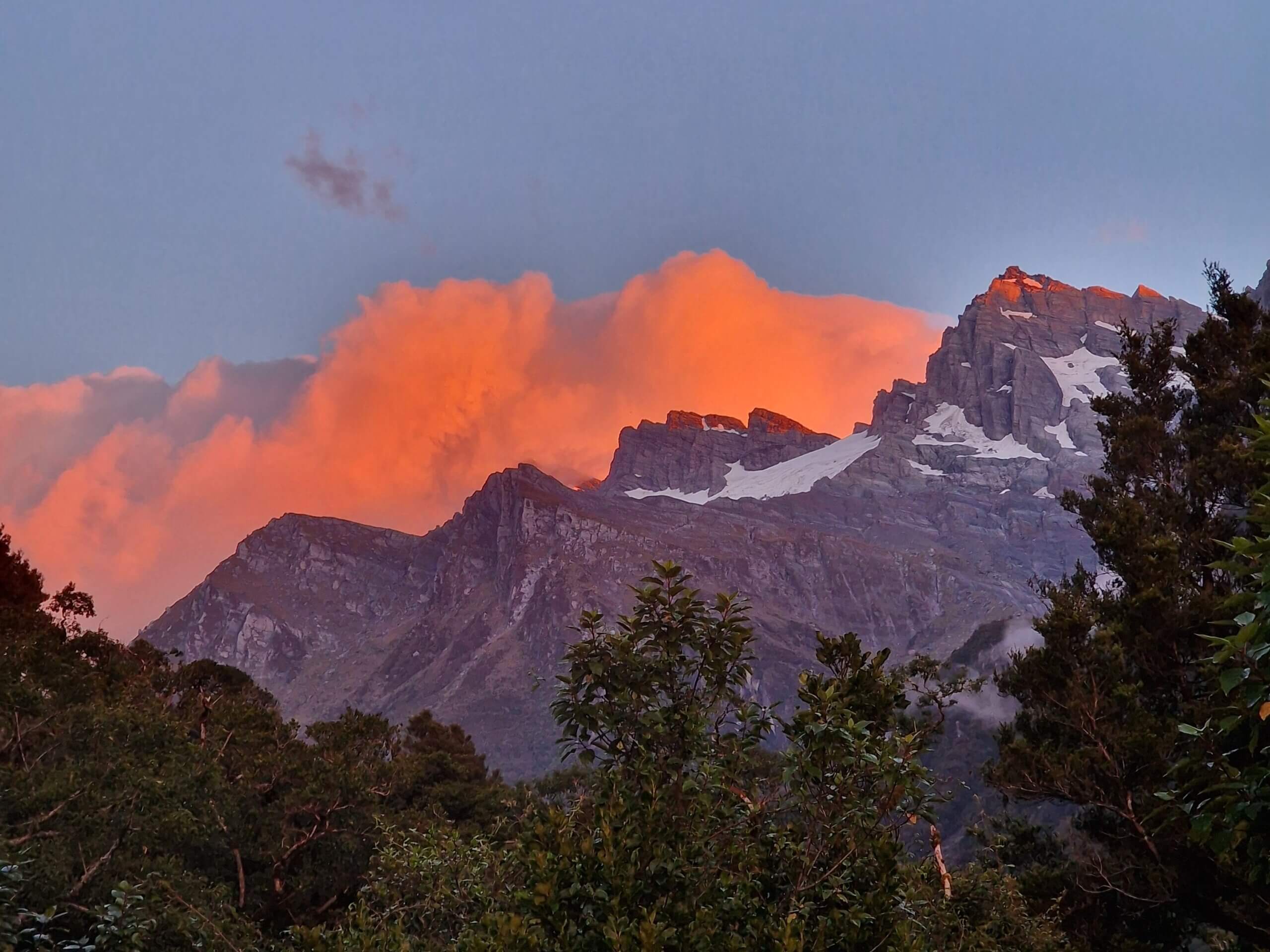
As day turned to night at Welcome Flat Hut, we were treated to an unforgettable sunset. It instantly ranked in my top three sunsets of all time, and how could it not? Pink pastel clouds wrapped around the snowy Sierra mountains, making the surrounding greenery pop. The heat from the pools mingled with the cool air, creating a misty, fairy-tale-like atmosphere. I was surrounded by great people and breathtaking nature.
Knowing how the weather on the West Coast tends to be bad, I couldn’t believe our luck. That night, I went to bed feeling grateful in every cell of my being.
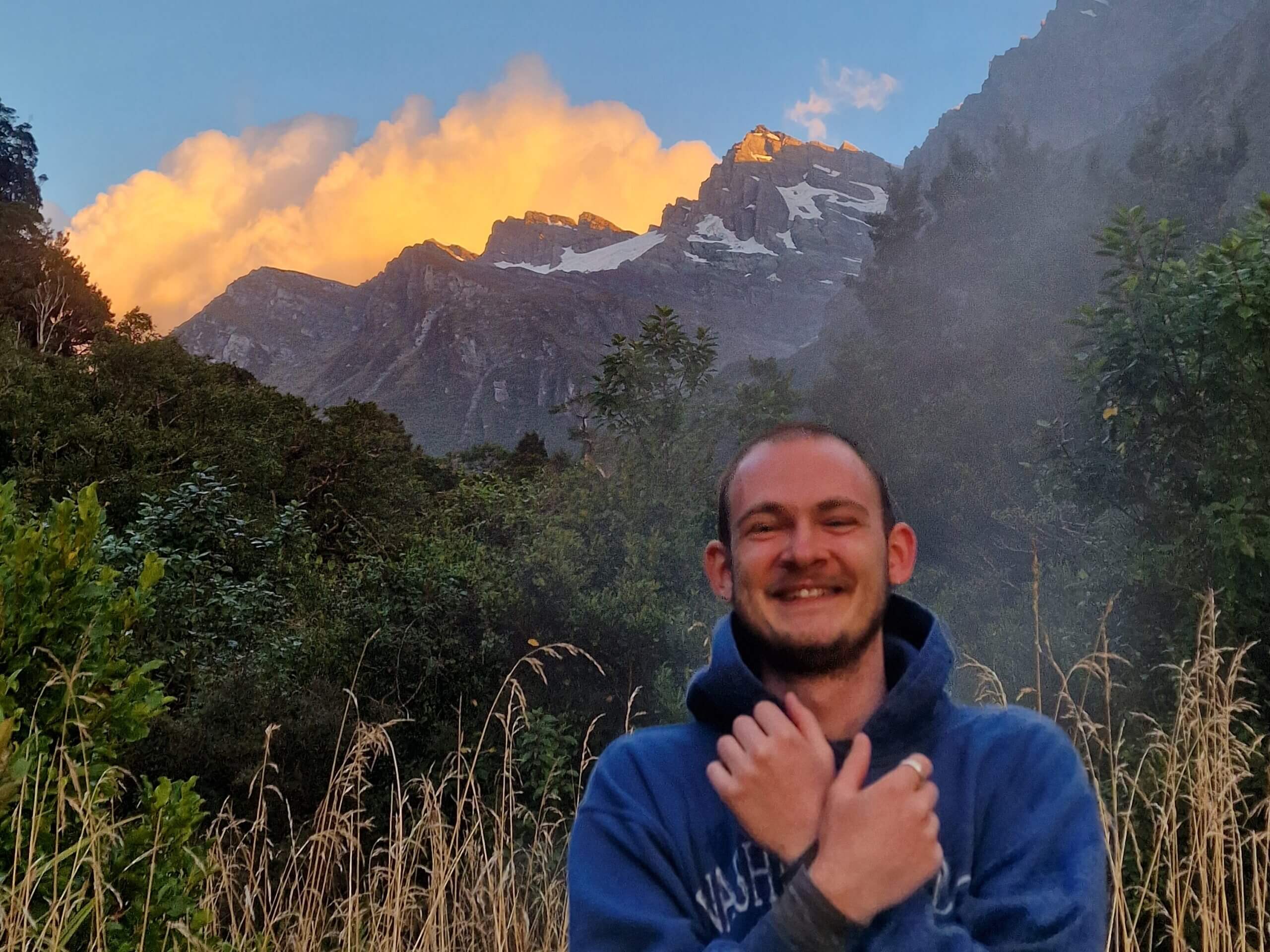
Back Down We Go
It wasn’t the worst of sleeps, it wasn’t the best, but I definitely felt fatigued the next day. Even shoveling food into my face didn’t shake it off. But as they say, there’s no rest for the wicked, especially when there’s still another 18 kilometers to cover back to the car park.
The boys and I packed up and set out on our descend. It was another rare dry day on the West Coast, and we were grateful for the ideal conditions. Step by step, we trekked onward. It was clear I wasn’t the only one who hadn’t slept well; the weight of our packs felt heavier today, our strides a bit slower, and for some reason, the trail seemed longer than it did yesterday. Still, we kept a steady pace.
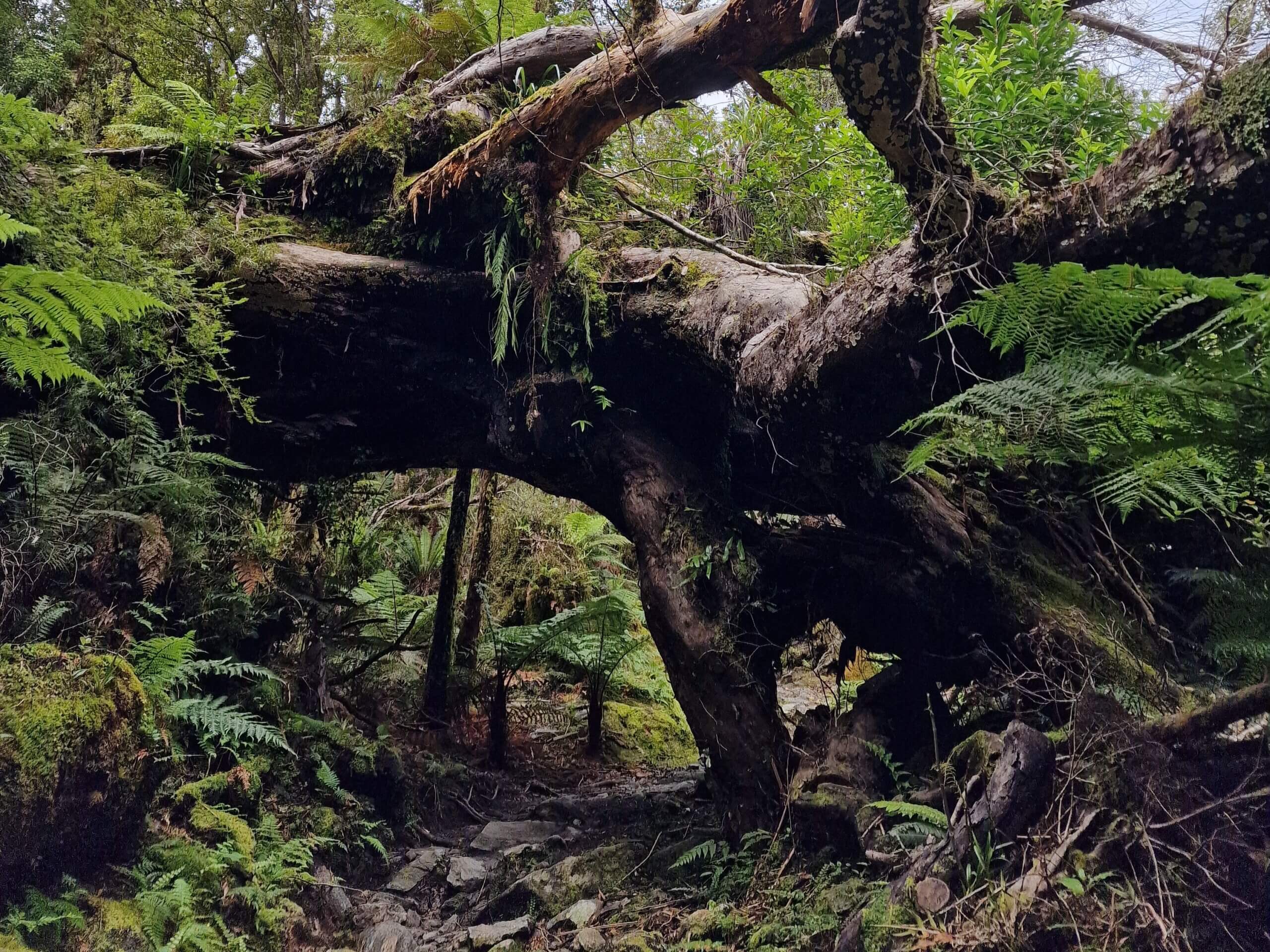
There were several spots where we were convinced that we were close to the car park now, but each time the trail stretched further, revealing sections we couldn’t recall from the day before. Eventually, though, we reached it, our spirits lifting like a cloud parting in front of the sun.
After a brief assessment of the Rough Creek crossing, we just went for it. The water was calm enough, so no real danger there. At the car park, we settled down, savoring our final moments together. I nibbled on a soggy carrot from my bag, Jack on some dry toast bread, and we snapped a group photo before bidding farewell.
This is the one thing I’ll never get used to when traveling: how you forge these intense connections with complete strangers on your journey. You share your dreams and fears, hopes and failures.
In a fleeting moment, they become integral parts of your story, weaving in and out like threads in a tapestry of experiences that define your travels.
But then, following the unwritten rules of travel, you part ways, and you’re left to ponder if you’ll ever cross paths again, carrying their memory and the shared moment with you for a lifetime.
FAQ
Visiting New Zealand
What is the currency in New Zealand, and how do I access money? The currency is the New Zealand Dollar (NZD). ATMs are widely available in towns and cities, but services may be limited in more remote areas like the West Coast. Credit cards are accepted at most establishments.
Do I need a visa to visit New Zealand? Visitors from many countries can enter New Zealand for up to 90 days without a visa under the visa waiver program. Check with the New Zealand Immigration website to confirm requirements based on your nationality.
What is the time zone in New Zealand? New Zealand operates on New Zealand Standard Time (NZST), which is UTC+12. During daylight saving time (NZDT), it is UTC+13.
What should I know about driving in New Zealand? In New Zealand, vehicles drive on the left-hand side of the road. If you plan to rent a car, ensure you have a valid driver’s license and familiarize yourself with local road rules, including speed limits and road signs.
What is the weather like in New Zealand? New Zealand has a temperate climate with mild temperatures year-round. However, weather can change quickly, especially in mountainous and coastal regions. Pack layers and be prepared for rain at any time, particularly on the West Coast.
Are there any cultural customs or etiquette I should be aware of? New Zealanders (Kiwis) are generally friendly and informal. Respect cultural protocols of Maori (indigenous) communities if visiting marae (meeting grounds). Remove shoes before entering someone’s home and greet with a handshake or hongi (Maori greeting).
What are the must-try foods and drinks in New Zealand? New Zealand is known for its seafood (like green-lipped mussels and bluff oysters), lamb dishes, and iconic desserts like Pavlova and Hokey Pokey ice cream. Don’t miss trying local wines, particularly Sauvignon Blanc and Pinot Noir.
Are there any safety considerations for outdoor activities in New Zealand? New Zealand’s natural landscapes are stunning but can be rugged. Always check weather forecasts, stay on marked trails, and carry essential gear like a map, compass, and emergency supplies. Inform someone of your hiking plans, especially for remote areas.
What are the tipping customs in New Zealand? Tipping is not expected in New Zealand, as it is not customary. Service charges are generally included in the bill, and tipping is discretionary for exceptional service.
Can I use my mobile phone in New Zealand? Most international mobile networks operate in New Zealand, but check with your provider regarding roaming charges. Alternatively, local SIM cards are available for purchase, and Wi-Fi is commonly available in accommodations and public spaces. You can also opt for an eSIM.
Visiting the West Coast and Hiking the Copland Track to Welcome Flat Hut
When is the best time to hike the Copland Track to Welcome Flat Hut? The best time to hike the Copland Track is during the New Zealand summer (December to February) when the weather is generally milder and more stable. However, be prepared for rain at any time due to the West Coast’s unpredictable weather patterns.
How difficult is the Copland Track? The Copland Track is considered moderately challenging. It involves river crossings, varied terrain, and potentially muddy sections. Good physical fitness and hiking experience are recommended.
Are there accommodations along the Copland Track? Yes, Welcome Flat Hut provides accommodation options. You need to book in advance.
What should I pack for the Copland Track? Essential items include sturdy hiking boots, waterproof clothing, insect repellent (for sandflies), a first aid kit, plenty of water, and food. Pack layers for variable weather conditions.
Are there facilities at Welcome Flat Hut? Yes, Welcome Flat Hut has basic facilities including bunk beds, cooking facilities, toilets, and nearby natural hot pools for soaking.
How do I get to the Copland Track trailhead? The trailhead is accessed via a gravel road off State Highway 6 near Fox Glacier. You can drive, hitchhike or take public transport.
What wildlife might I encounter on the Copland Track? The track passes through native bush where you may see native birds like kea (alpine parrots), and possibly deer or other native wildlife. Respect their habitat and observe from a distance.
How should I prepare for river crossings along the Copland Track? Be prepared to cross rivers safely by assessing conditions, unbuckling your backpack, using trekking poles for stability, and crossing as a group if possible. Check weather forecasts and river levels before starting your hike.
What are the natural hot pools at Welcome Flat Hut like? The natural hot pools are geothermally heated and vary in temperature. Visitors can soak in the mineral-rich waters amidst stunning mountain scenery. Remember to keep your head above water to minimize health risks.
Are there day hiking options near Welcome Flat Hut? Yes, you can explore nearby tracks such as the Copland Pass Route or simply relax at the hot pools. Day hikers should still be prepared with appropriate gear and follow safety guidelines.
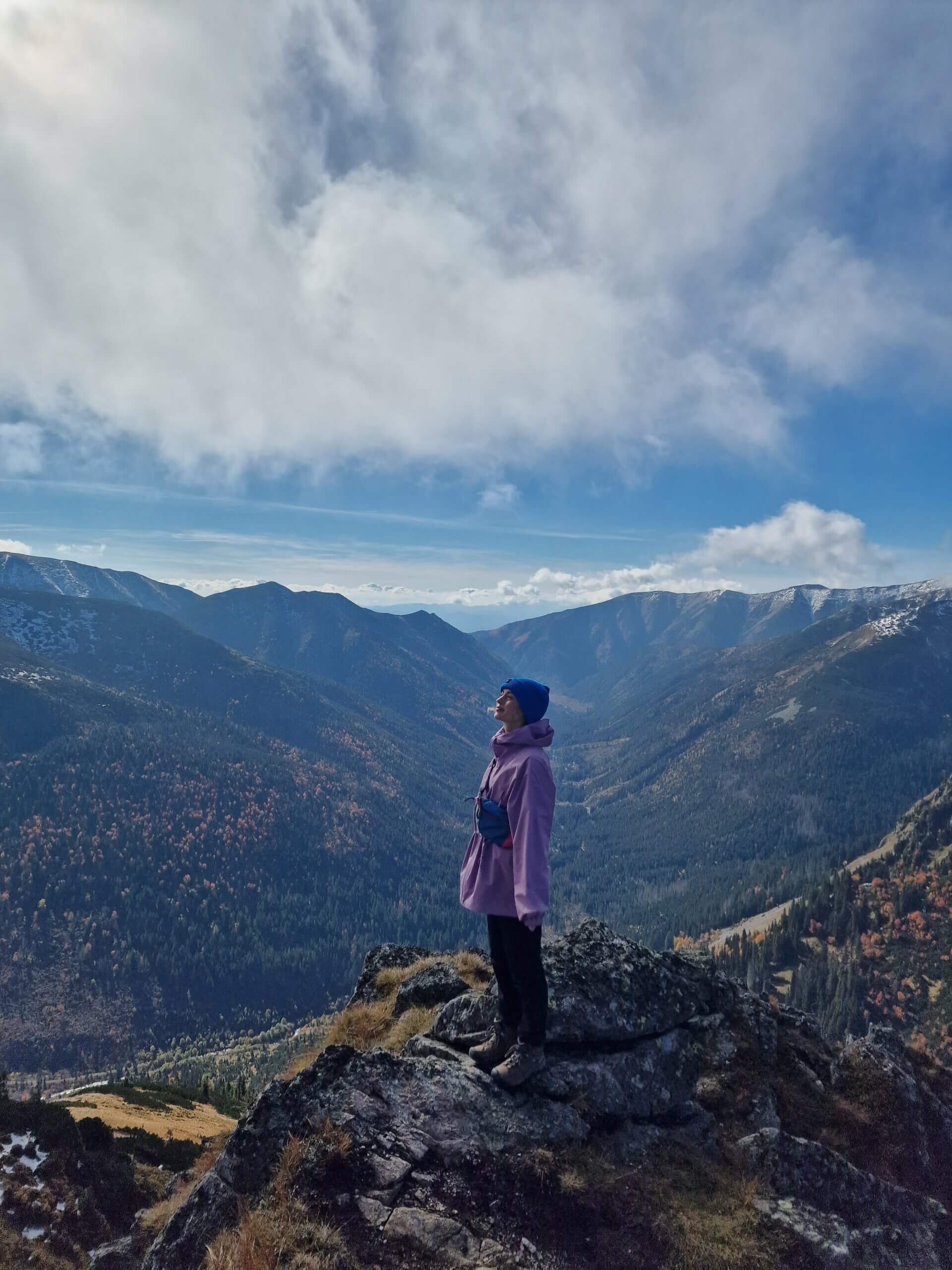

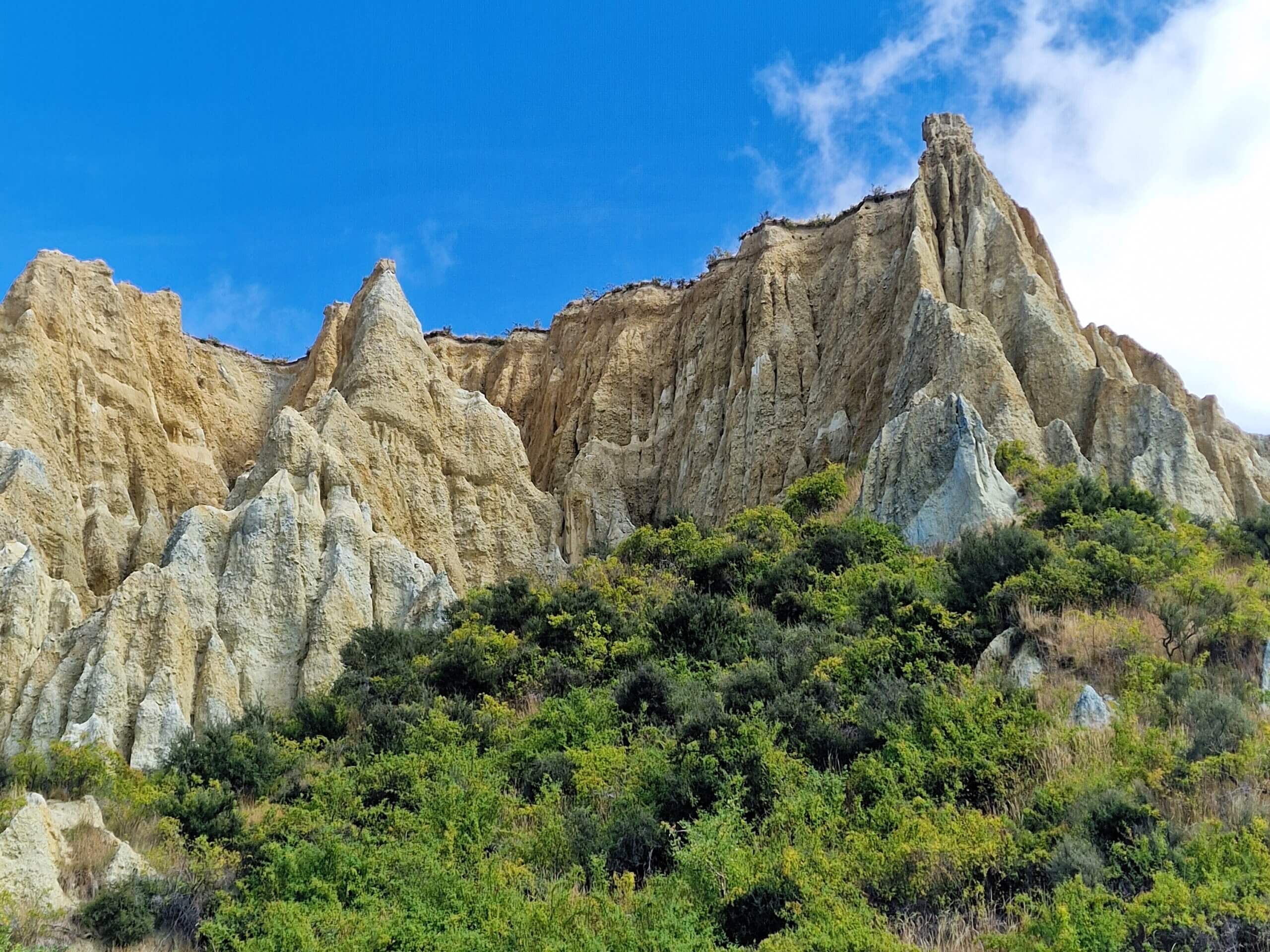
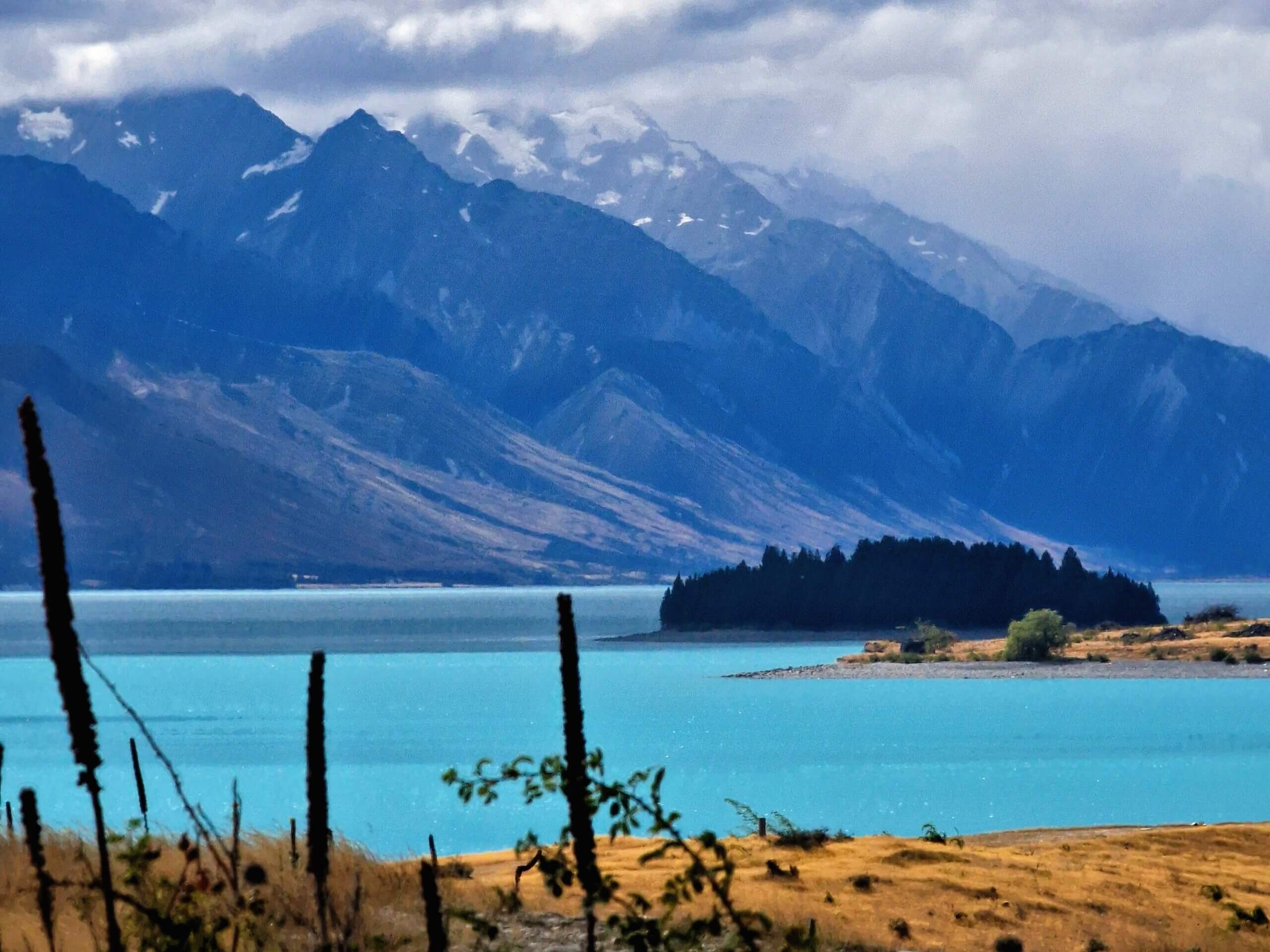
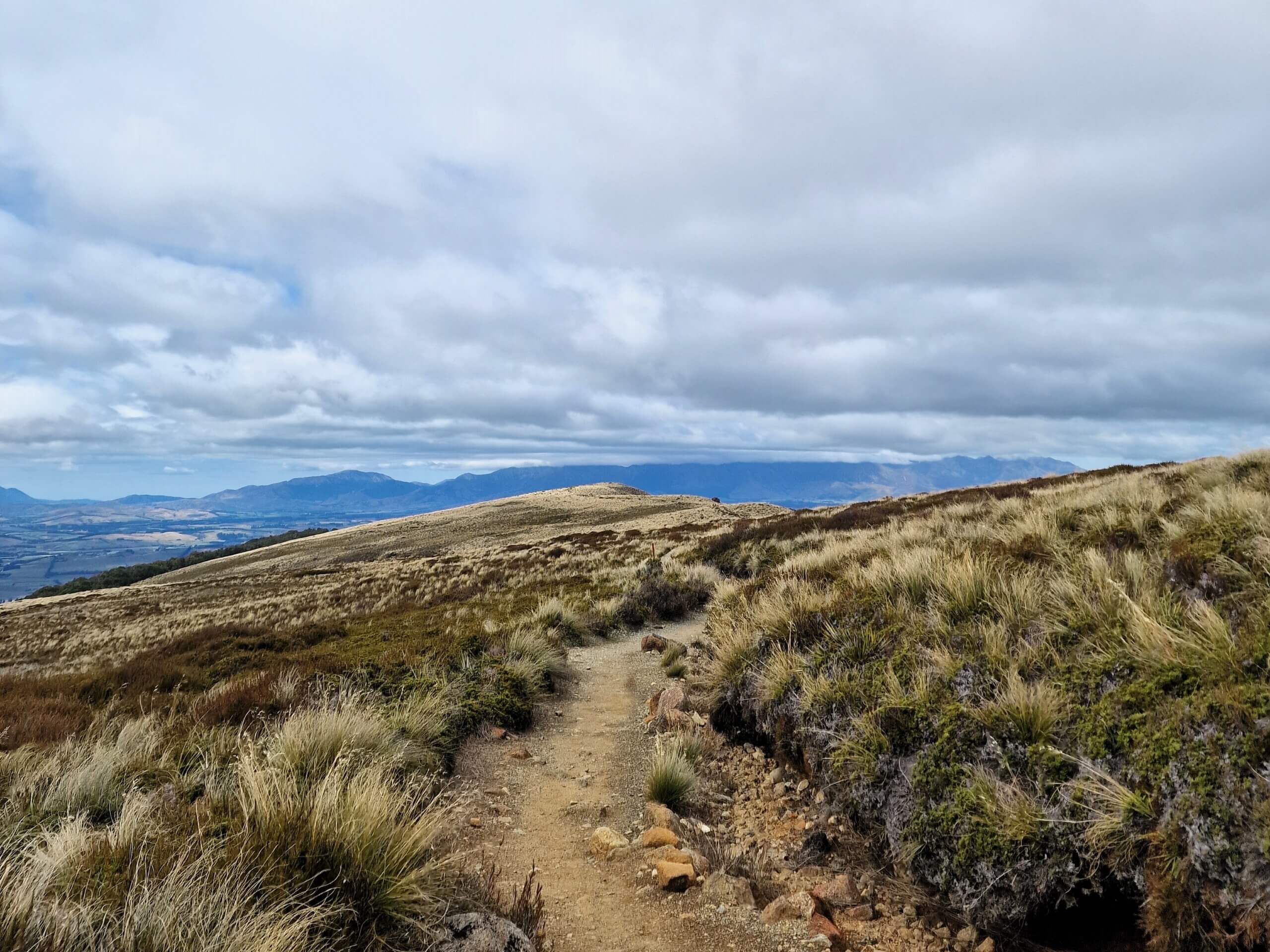
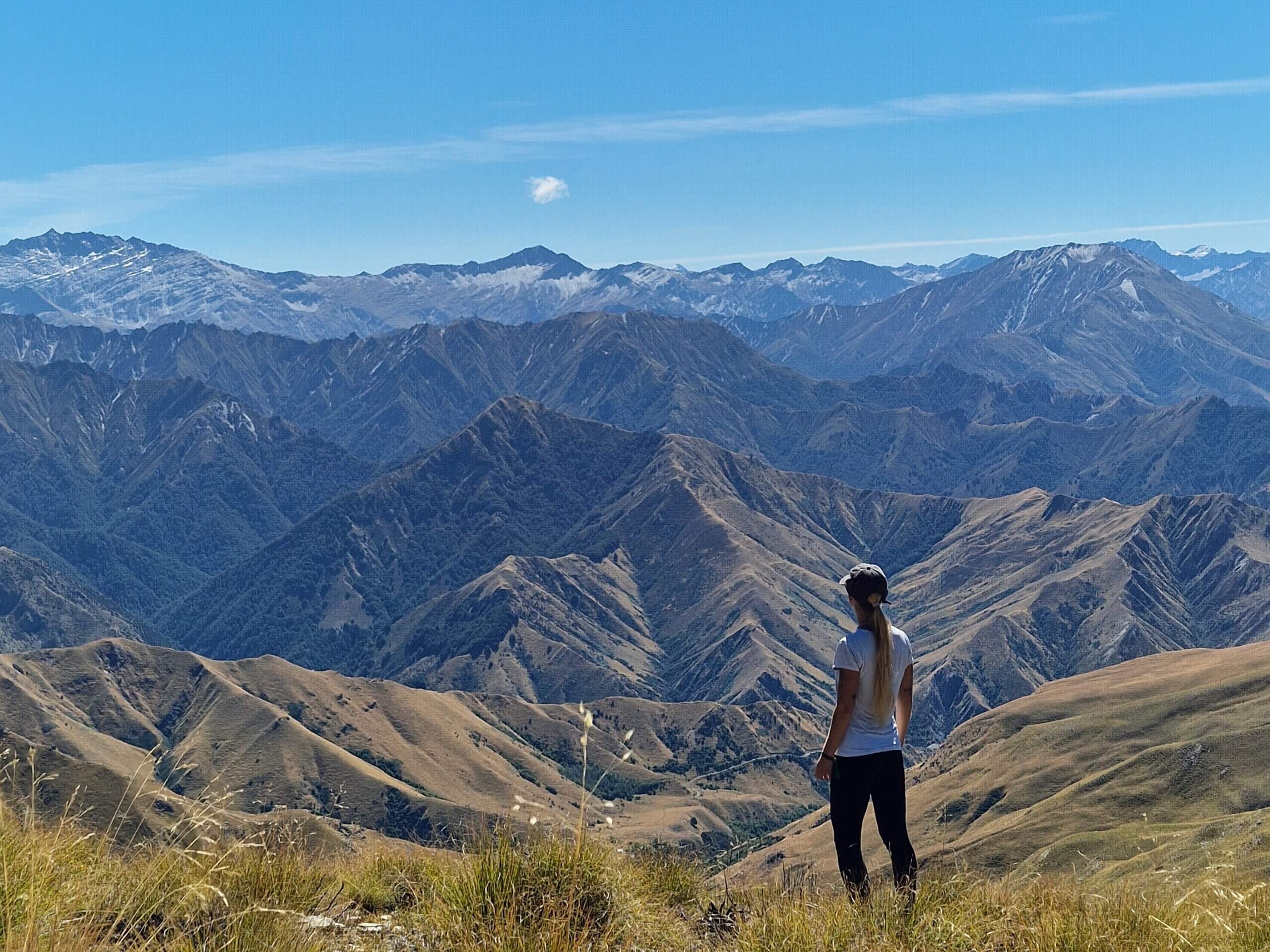
Leave a Reply